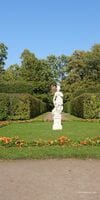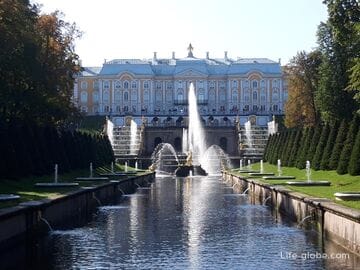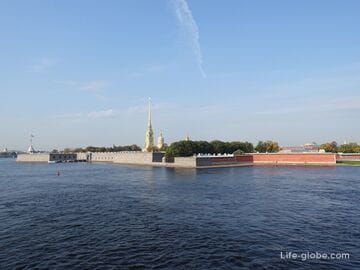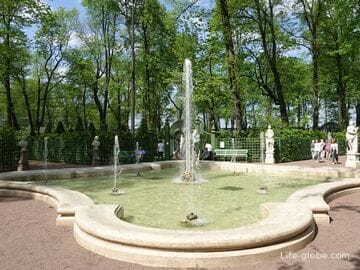The city of Pushkin (formerly Tsarskoye Selo, until 1918) is a city in the Pushkin district of the federal city of St. Petersburg.
Until 1918, Tsarskoye Selo was the imperial country ceremonial residence.
And today, the city of Pushkin already keeps within its borders the restored palace and park ensemble of the 18th and 19th centuries and other significant sights, as well as museums, parks, churches and an observation deck located on the roof of the former water tower, from which beautiful panoramic views of the former Tsarskoye Selo open.
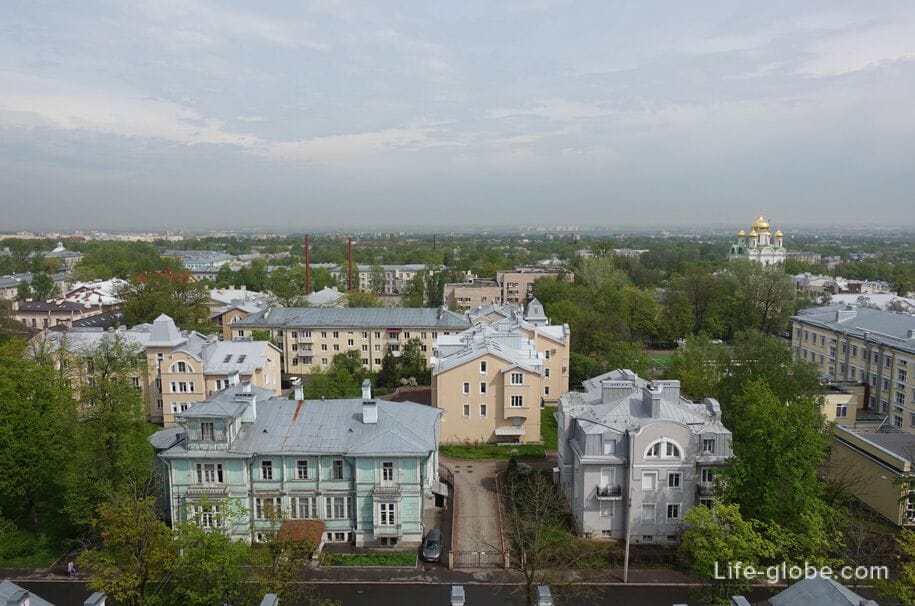
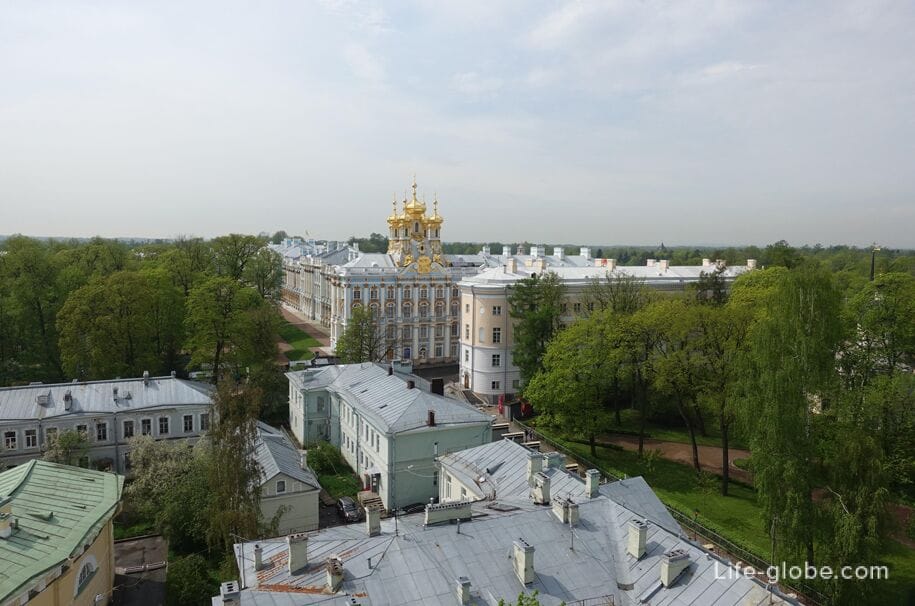
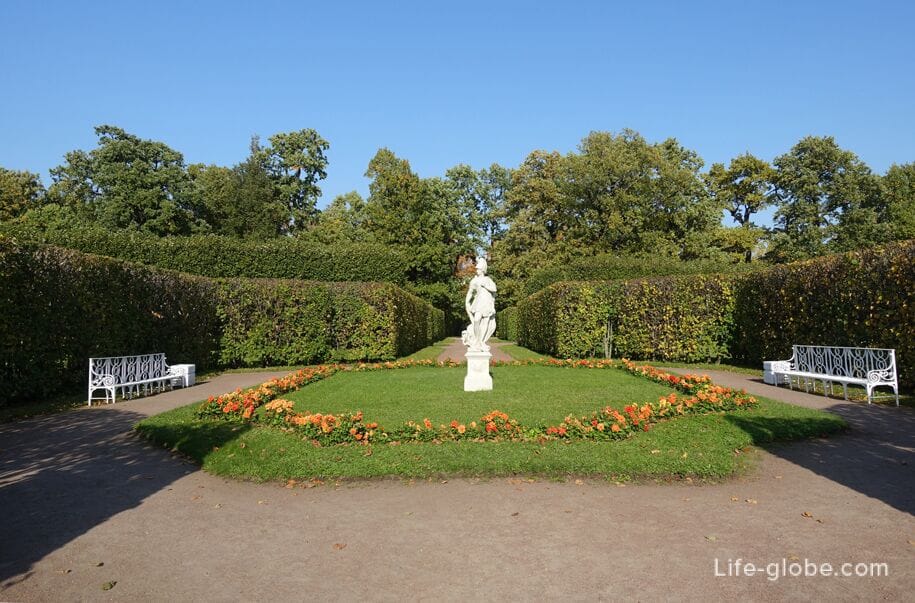
Sights of Pushkin. Sights of Tsarskoye Selo
Catherine Park with the Catherine Palace
Catherine Park is a large park that is the dominant feature of the Tsarskoye Selo complex, as well as one of the most picturesque and visited parks in St. Petersburg.
The name" Catherine " park was named after the Catherine Palace located in the park, named in honor of Catherine I.
The compositional center of the park's ensemble isThe Great Tsarskoye Selo (Catherine) Palace, which is a magnificent example of the Russian Baroque with luxurious interior decorations in the spirit of the Elizabethan and Catherine eras with unique works of fine and applied art.
In the palace (for a fee) you can visit the restored palace halls, as well as (for a fee) - the church of the Catherine Palace (Resurrection of Christ), located in the palace wing. In addition, temporary exhibitions are held in some halls of the palace. Learn more about the Catherine Palace…
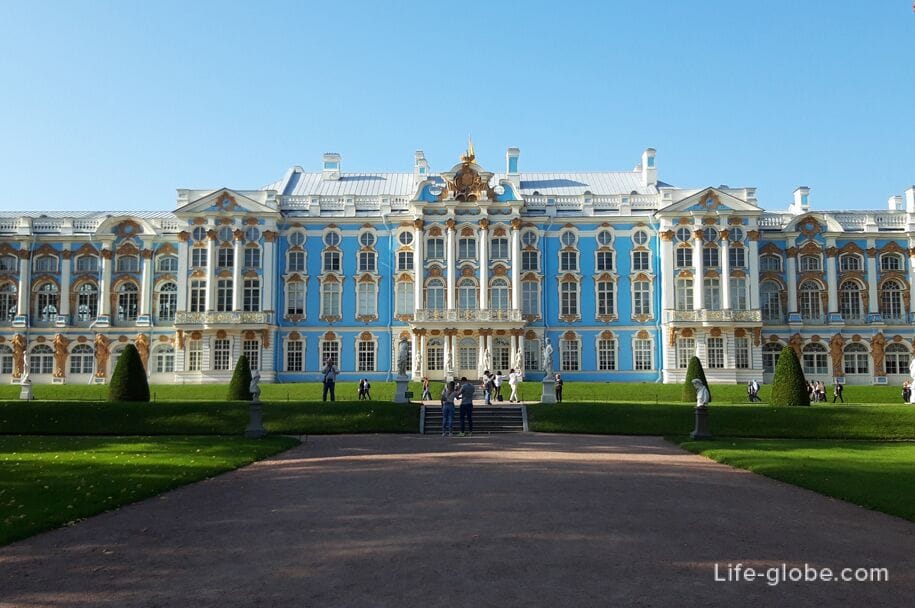
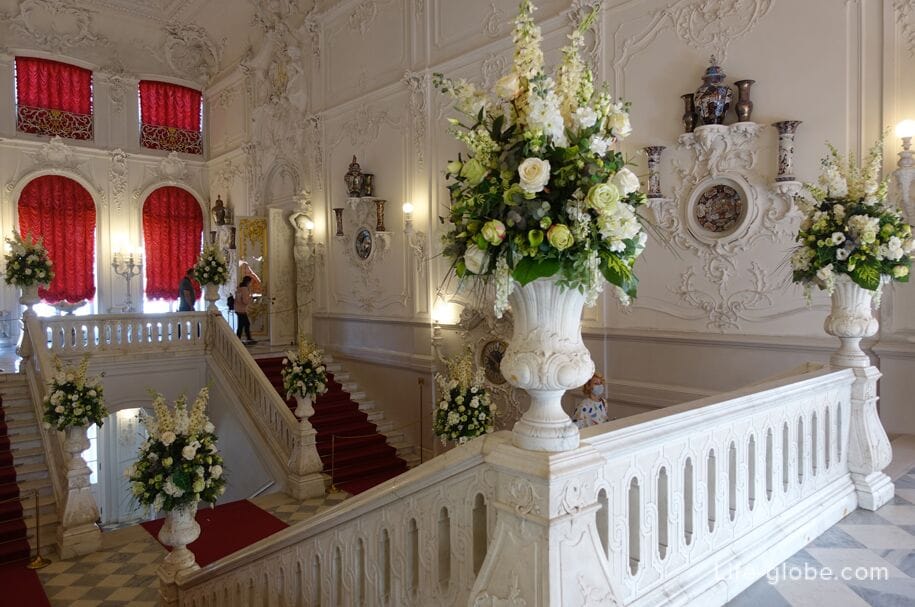
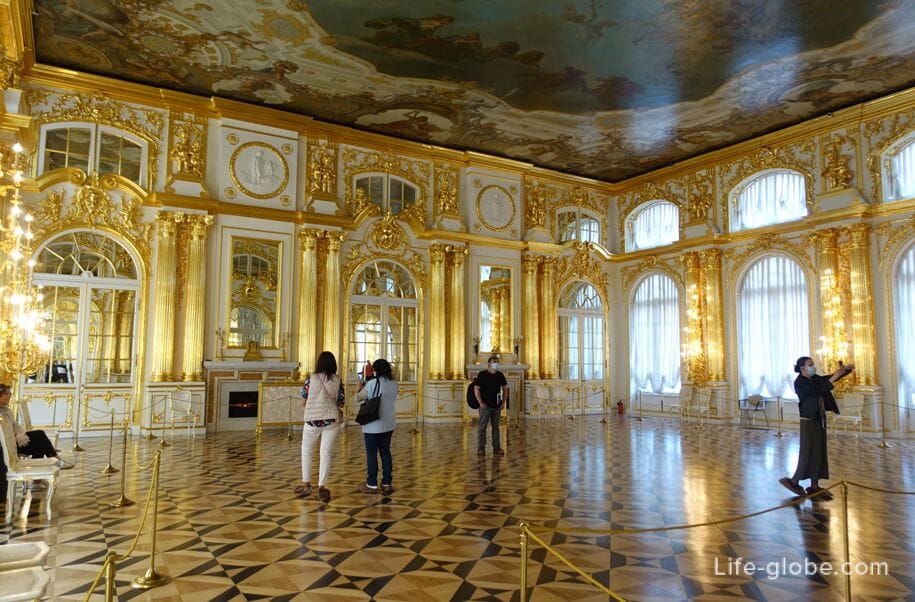
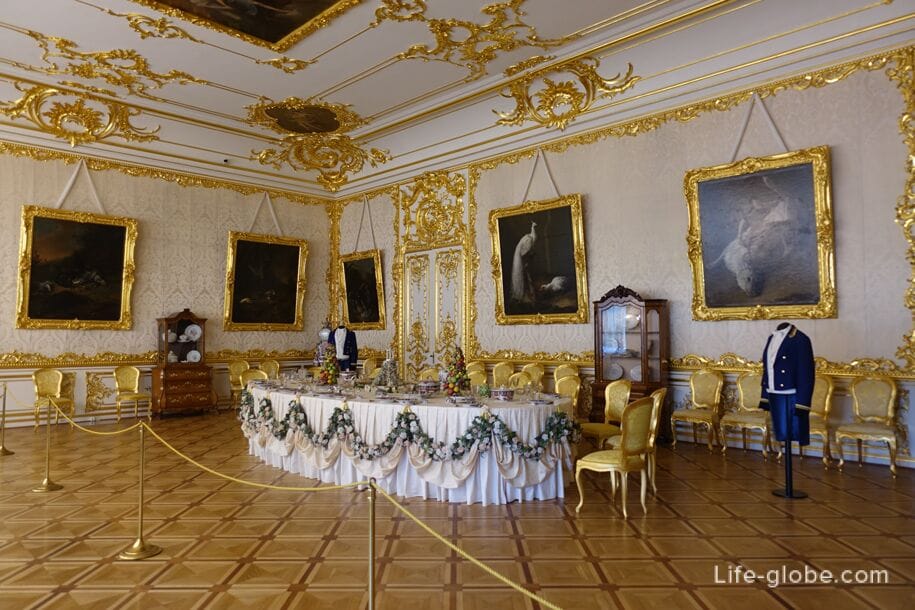
The Catherine Palace is adjacent to the eponymousCatherine Park, which has an area of more than 100 hectares.
The park consists of two parts: a regular Old Garden and a landscape English park.
On the territory of the Catherine Park there are: pavilions, some of which now contain museums, sculptures, monuments and bridges erected in various architectural styles, as well as piers, ponds, flower beds, alleys and walking paths with places for recreation.
In the Catherine Park there are such attractions as: Cameron's terms, Upper and Lower baths, Grotto Pavilion, Hermitage Pavilion, Hermitage kitchen, A large pond with a Chesma column and a pavilion Hall on the island, Admiralty, Turkish Bath Pavilion, Concert Hall pavilion, Creaky Chinese gazebo, pavilion Evening Hall, The tower is a ruin, Granite terrace, Marble Bridge, The Cahul obelisk, the fountain "Girl with a jug" and others.
Entrance to the park is paid. Learn more about the Catherine Park…
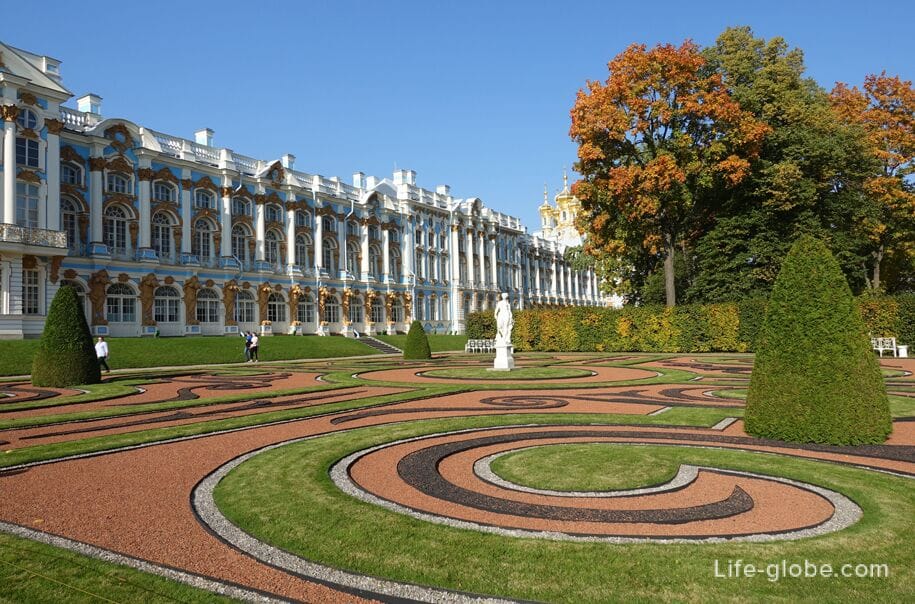
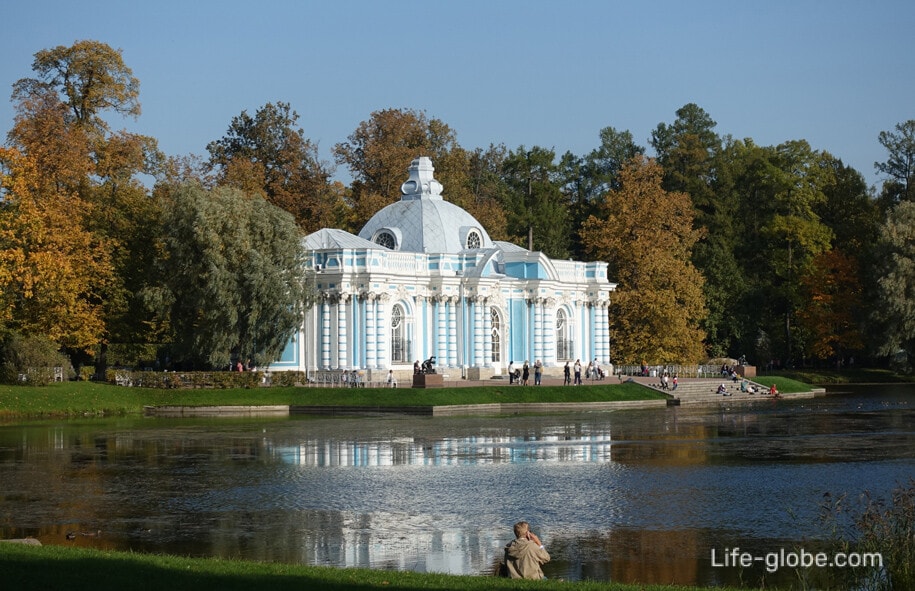

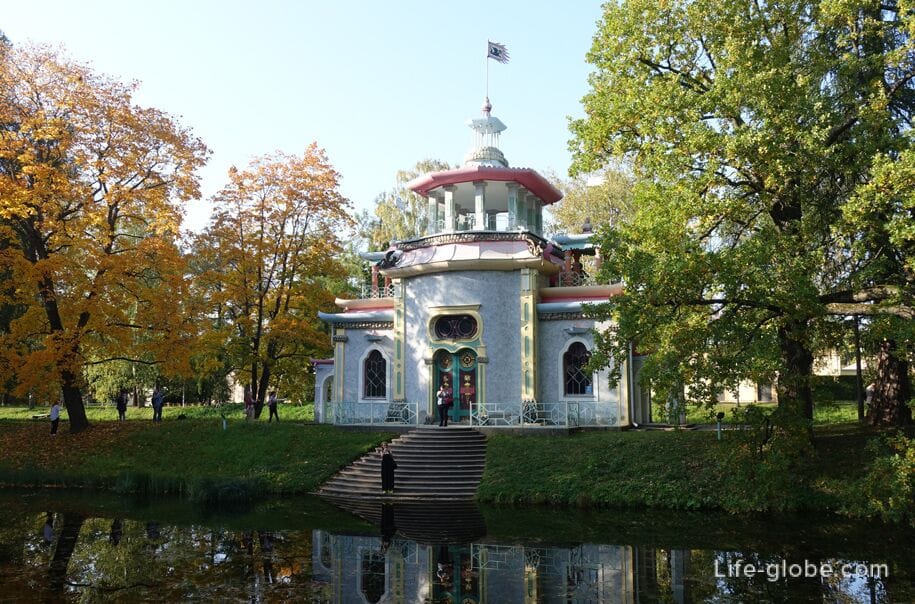
Alexander Park with the Alexander Palace
The Alexander Park, which has an area of about 200 hectares, is adjacent to the Catherine Park and the palace. and consisting of a New garden (a regular part of the park with a geometrically correct layout) and a Landscape Park.
The main dominant feature of the park isThe Alexander Palace, which is one of the best creations of classical architecture.
The palace was built by order of Empress Catherine II as a gift for the wedding of her grandson, Grand Duke Alexander Pavlovich (the future Emperor Alexander I) with Grand Duchess Elizabeth Alekseevna.
Within the walls of the palace there are: A corner living room, a hall with a slide, a Library, a State office of Nicholas II, a Moorish lavatory, a study, a Reception Room of Nicholas II, Bedrooms, a Lilac study of Alexandra Feodorovna, a Rosewood reception room of Alexandra Feodorovna, a Maple living room, etc.

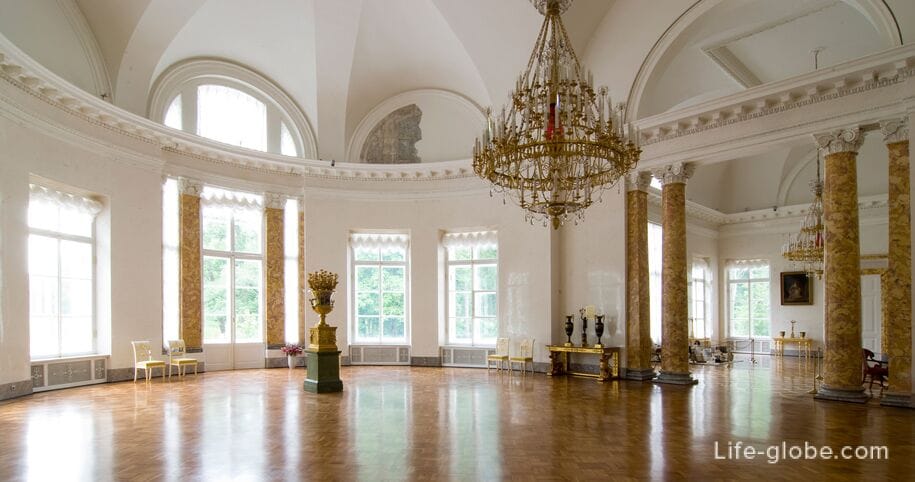
In addition to the palace, on the territory of the Alexander Park there are: pavilions, one of which now houses a museum (Arsenal), the White Tower complex, the Chapelle in the form of an old ruined temple, a Chinese village, monuments and bridges erected in various architectural styles, as well as ponds, low hills, natural forest areas, alleys and paths for walking with places to relax.
Of the most famous bridges in the park: Great Chinese Bridge, Small Chinese bridges, Dragon Bridge and The Cross Bridge.
The entrance to the Alexander Park, with the exception of the entrance to the palace and the Arsenal pavilion-Museum, is free (free). Learn more about the Alexander Park and the Alexander Palace…
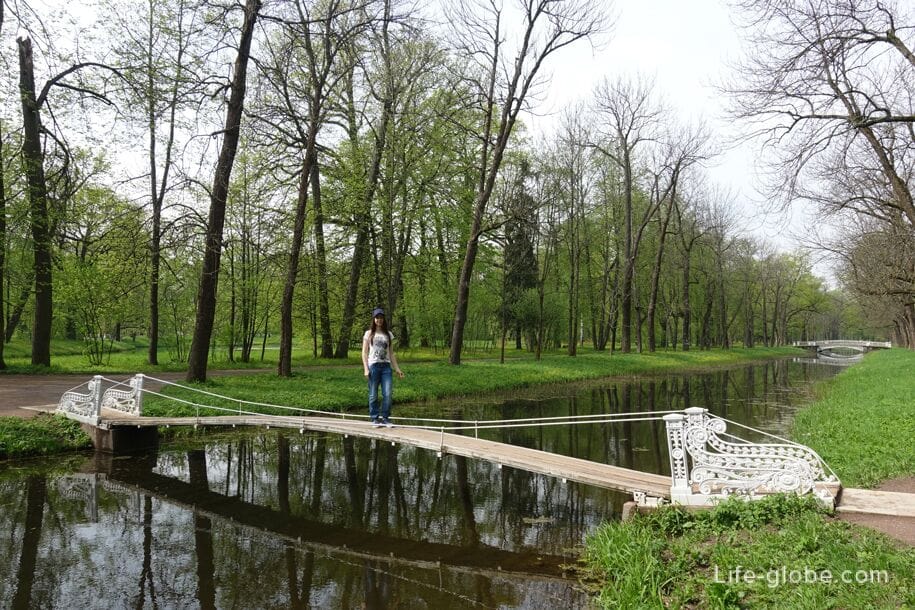


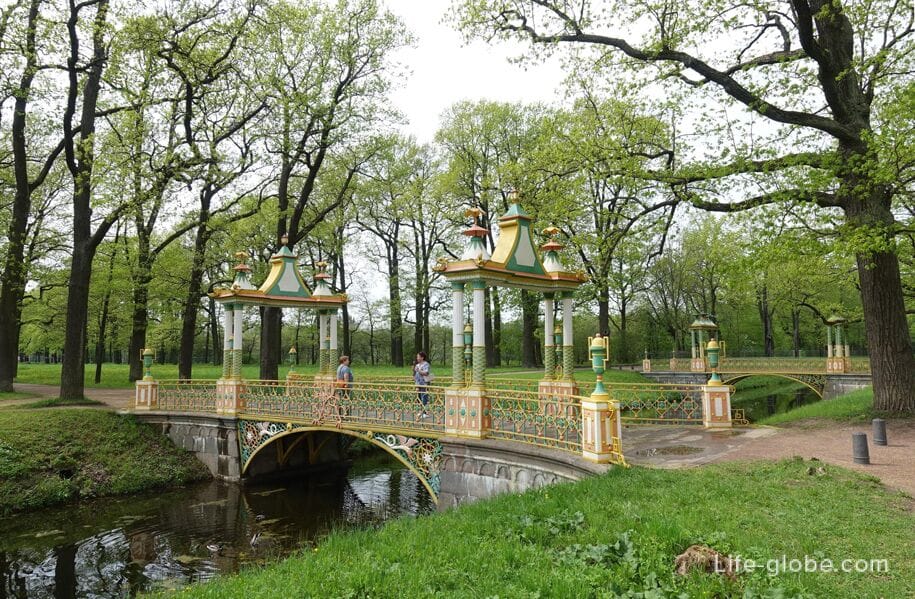
Duty stable with the exhibition "Court carriage in Tsarskoye Selo"
The building of the duty stable was erected in 1822-1827 according to the project of architects Vasily Petrovich Stasov and Smaragd Loginovich Shustov.
These were the emperor's own stables, located not far from the Catherine Palace with the adjacent park.
The building was damaged during the Great Patriotic War. It was later restored.
The walls of the court stable today house the permanent exhibition "The Court Carriage in Tsarskoye Selo", which presents a collection of 25 imperial carriages made by Russian and Western European masters of the 18th and 19th centuries, including ceremonial carriages, as well as walking and city carriages, children's carriages and sleds, which were once items of personal imperial use.
The address of the museum: Sadovaya Street, 8. Learn more about the stable and the exhibition...
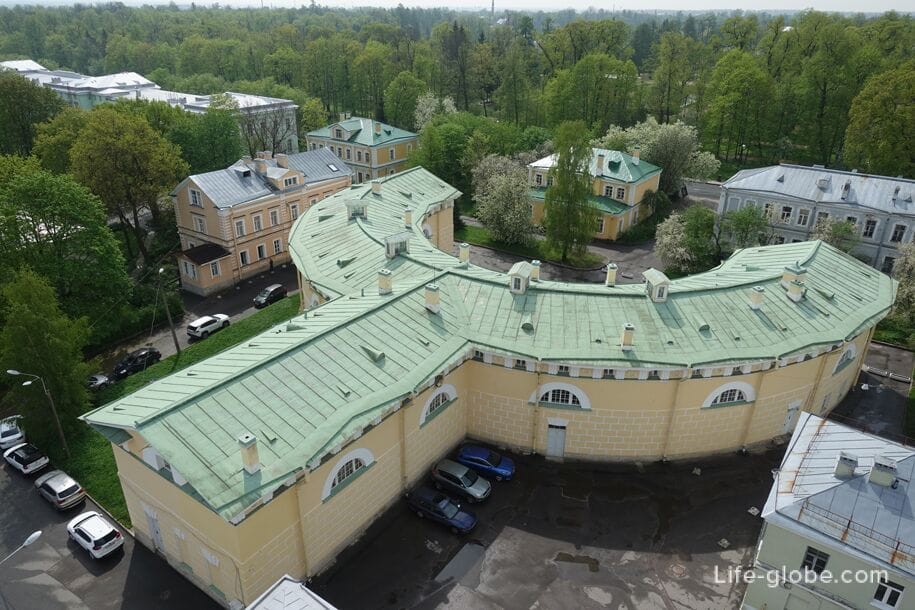

The Imperial Farm Complex
The complex of the Imperial Farm was built by A. A. Menelas in 1818-1828 and consisted of a pavilion of the highest presence, a Dairy, a cowshed, sheds for merinos, a caretaker's house and other buildings on the meadows of the park adjacent to the complex of the Imperial Farm, where cattle were grazed.
At present, the best preserved buildings of the Imperial Farm are the Cowshed building and the Caretaker's House, built of red brick.
Now the Equestrian Complex of the museum-reserve is located on part of the territory of the former Imperial Farm.
The farm complex is located in the northern part of the Alexander Park (now outside the park, across the Farm Road).
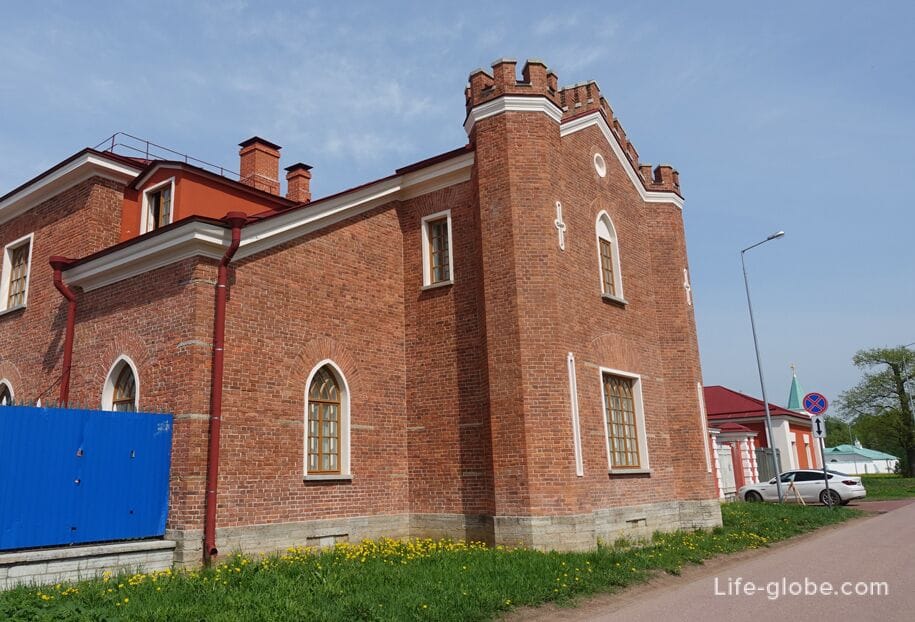

Military Chamber-Museum of the First World War "Russia in the Great War"
The military Chamber is a monument of architecture of the neo-Russian style and consists of a complex of buildings, in the center of which there is a courtyard.
The military history museum "Russia in the Great War", dedicated to the participation of the Russian Empire in the First World War, is located within the walls of the military chamber.
The address of the military chamber: Farmskaya road, 5A. Read more about the Military Chamber and the Museum with photos…
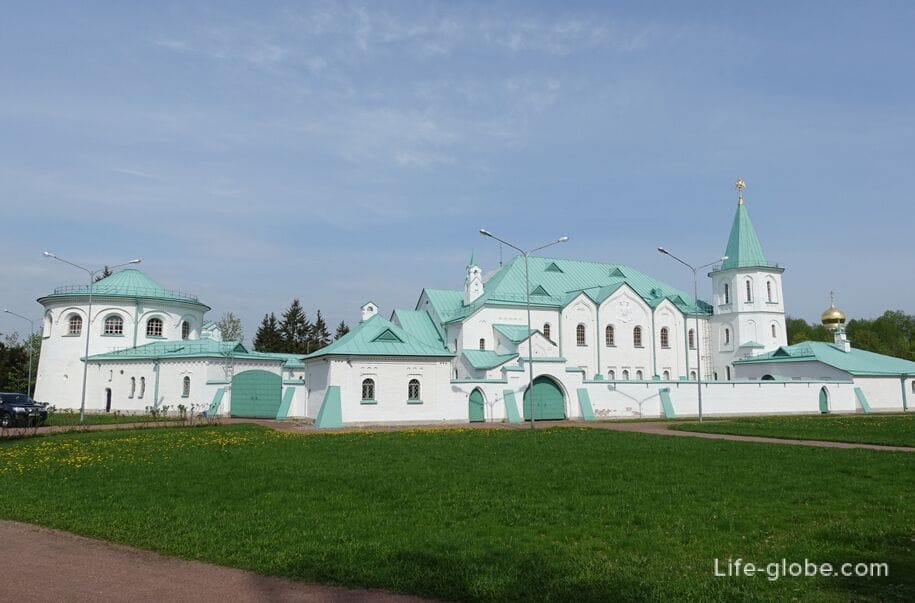
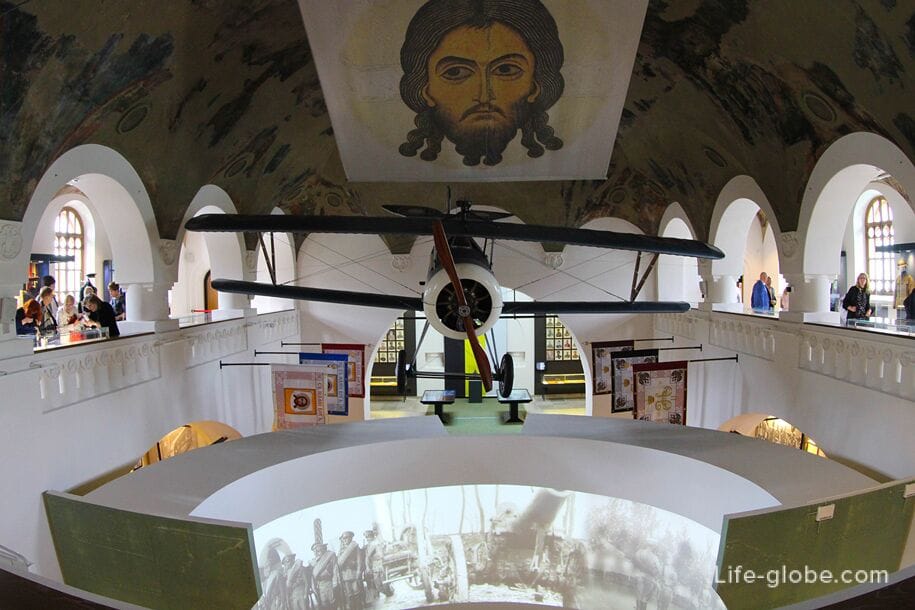
!!! All of the above objects with parks, palaces and museums belong to the State Museum-Reserve "Tsarskoye Selo".
For detailed information about the objects of the museum-reserve "Tsarskoye Selo", opening hours, ticket prices, places and conditions for their purchase and visiting the objects of the museum-reserve, we recommend checking onthe website of the State Museum-Reserve "Tsarskoye Selo": tzar.ru.
Feodorovsky Sovereign's Cathedral and Feodorovsky town
The Feodorovsky Sovereign Cathedral with the adjacent complex of buildings, which is called the Fedorovsky town (original name: Houses for the clergy and employees of the Fedorovsky Sovereign Cathedral) were built in Tsarskoye Selo by 1912-1918 by the decree of the last Russian Emperor Nicholas II.
The main idea of the construction was the visualization of the history of Russian architecture and art from the 12th to the 17th centuries. The complex embodies the idea of the image of Holy Russia.
In 1991, the Tsar's Cathedral, and with it the town, was transferred to the Russian Orthodox Church.
The address of the Feodorovsky Cathedral: Academic Ave., 34. The cathedral's website: gosudarev.cerkov.
The address of the Feodorovsky town: Academic Lane, 28. The site of the town: russianstyle.ifmo.
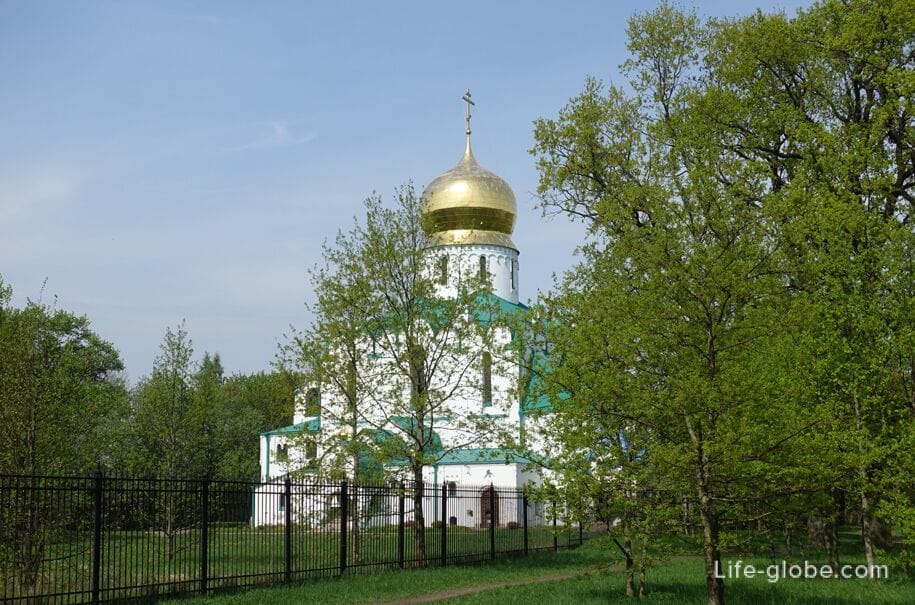
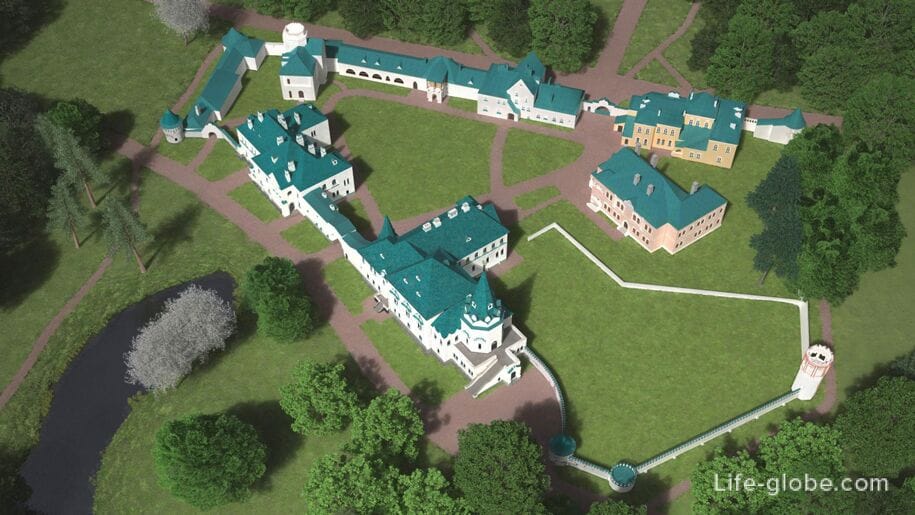
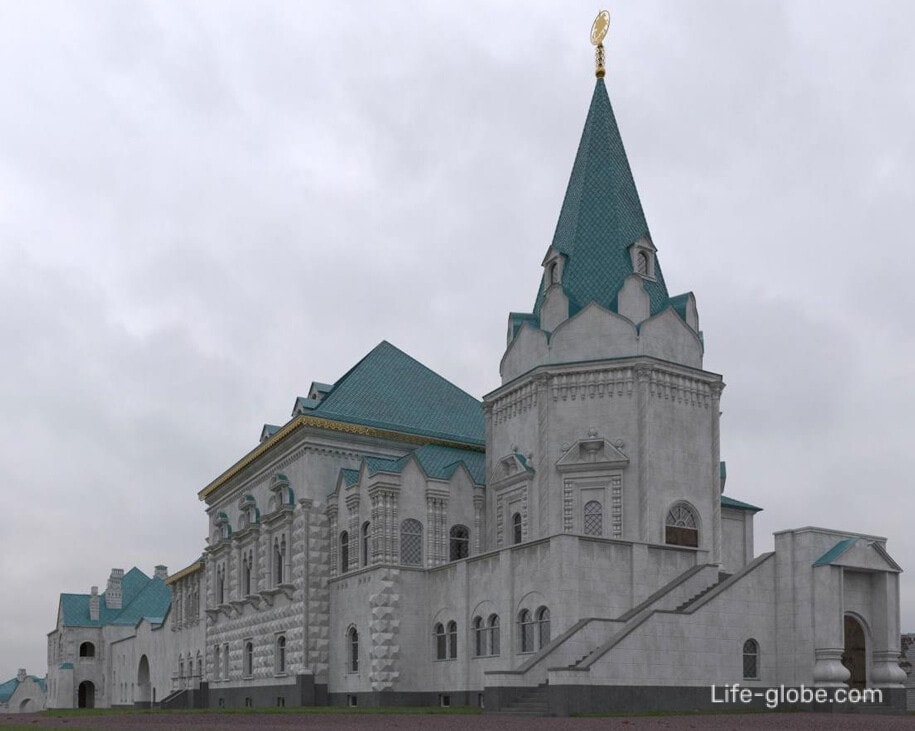
Singing Tower
The Singing Tower is a historical structure that was built as a water tower in 1887 according to the project of the academician of architecture Alexander Fomich Vidov, when the construction of a water pipeline in Tsarskoye Selo was started.
Today, the tower building has been restored, has a height of 30 meters and seven floors, as well as extensions, whichinclude : restaurants, a karaoke bar, a 5-star hotel Singing Tower, a souvenir shop, a banquet hall and an outdoor observation deck located on the roof of the tower.
The address of the Singing water tower: Lyceum Lane, 7. Learn more about the tower and the observation deck…
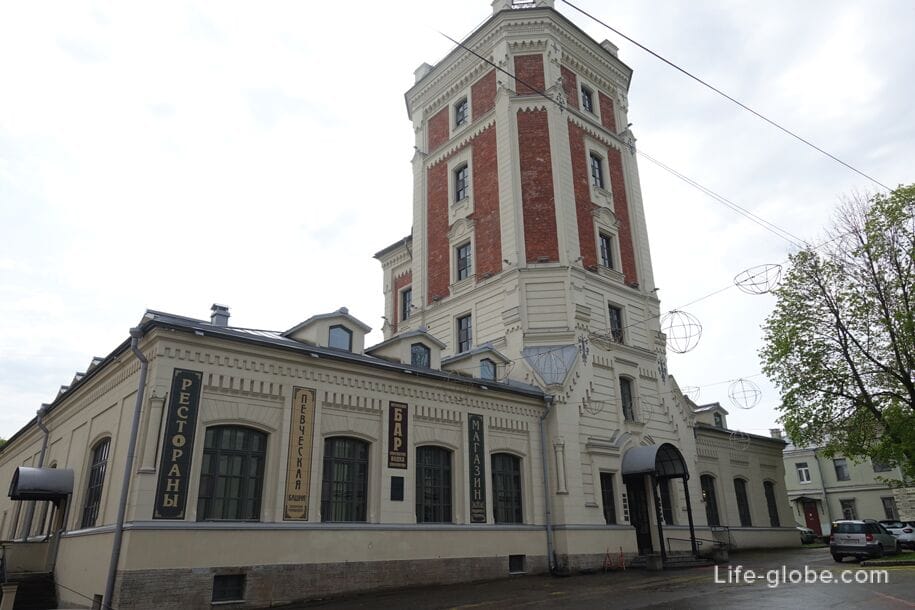

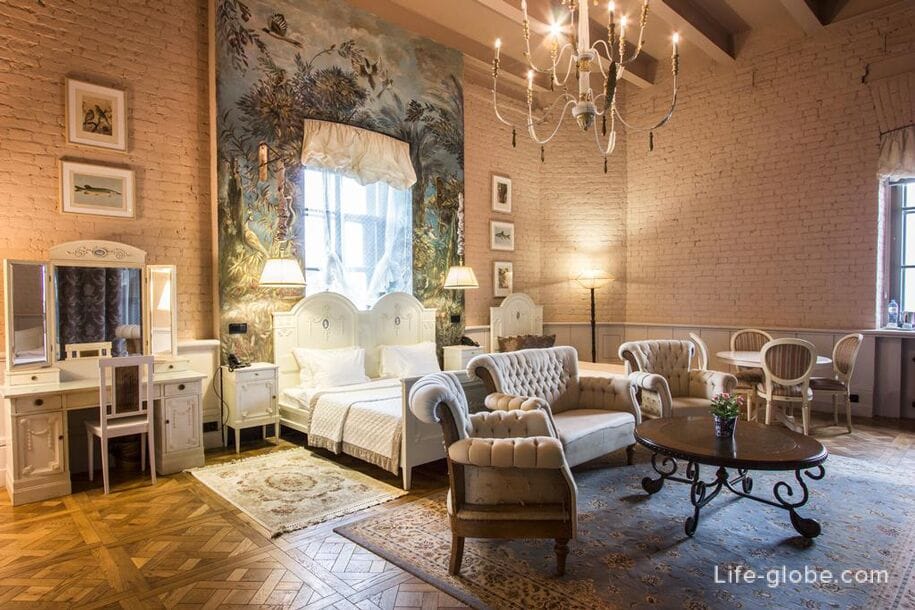
The Museum-dacha of A. S. Pushkin
The Pushkin Dacha Museum is a memorial museum of Alexander Sergeevich Pushkin.
The museum is located in the former house of the widow of the court valet Anna Kitaeva, where Alexander Sergeevich Pushkin rented a dacha (8 rooms) from May 25 to mid-October 1831. Pushkin arrived in Tsarskoye Selo with his wife Natalia Nikolaevna shortly after the wedding.
Among the rooms in the dacha museum, you can visit the dining room, living room, boudoir, bedroom and the recreated study of the poet in the mezzanine of the house.
The interiors of the rooms recreated according to the memoirs of contemporaries, as well as the materials presented in the museum's exposition tell the guests about the life and work of the poet.
A special section of the exhibition is dedicated to the stay in Tsarskoye Selo of N. M. Karamzin and V. A. Zhukovsky, senior contemporaries and literary mentors of Pushkin.
The address of the memorial museum-dacha of A. S. Pushkin: Pushkinskaya Street, 2/19. Read more about the Pushkin Dacha Museum…
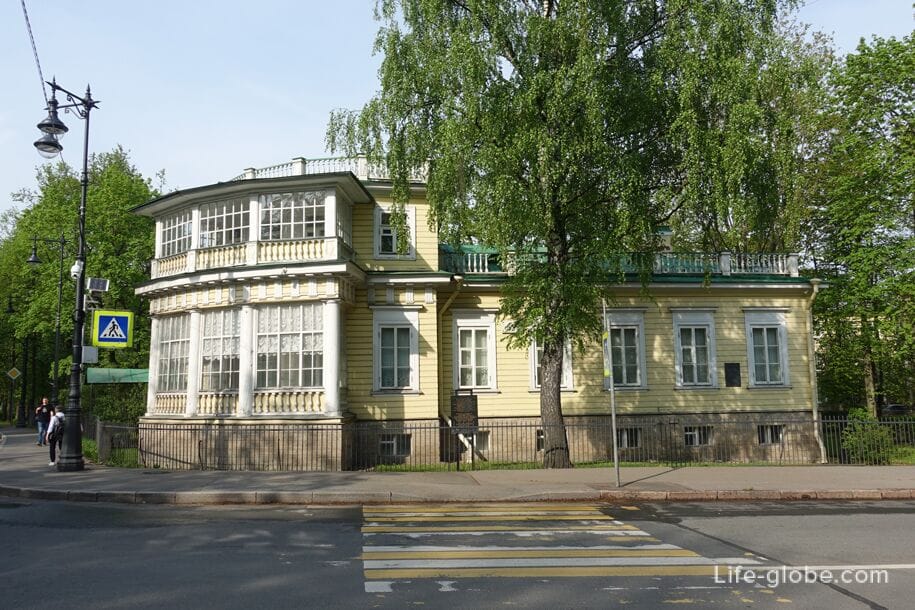
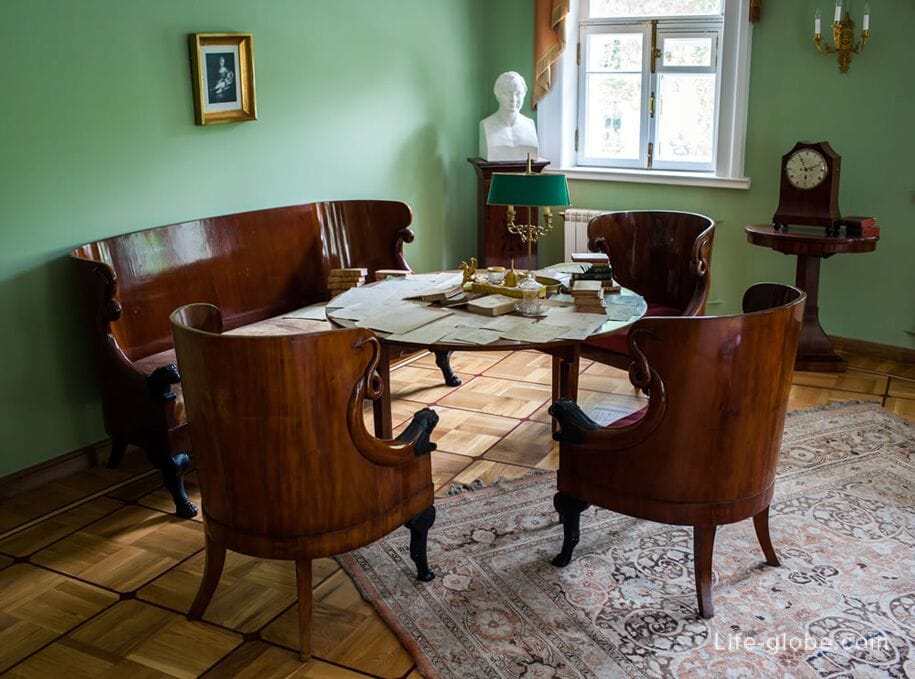
Memorial Museum-Lyceum
The Memorial Lyceum Museum is located within the walls of the former Imperial Tsarskoye Selo Lyceum, where Alexander Sergeevich Pushkin was educated from 1811 to 1817.
The museum recreates the atmosphere in which the lyceum students of the first edition, including Alexander Sergeevich Pushkin, lived and studied.
On the basis of archival materials, the Great Hall, the Newspaper Room, the library, classrooms, some of the pupils ' bedrooms, as well as the apartment of the tutor and the drawing teacher S. G. Chirikov were restored. All these rooms can be visited in the Lyceum museum.
The address of the memorial Museum-lyceum: Sadovaya Street, 2. More information about the memorial museum-lyceum with photos…

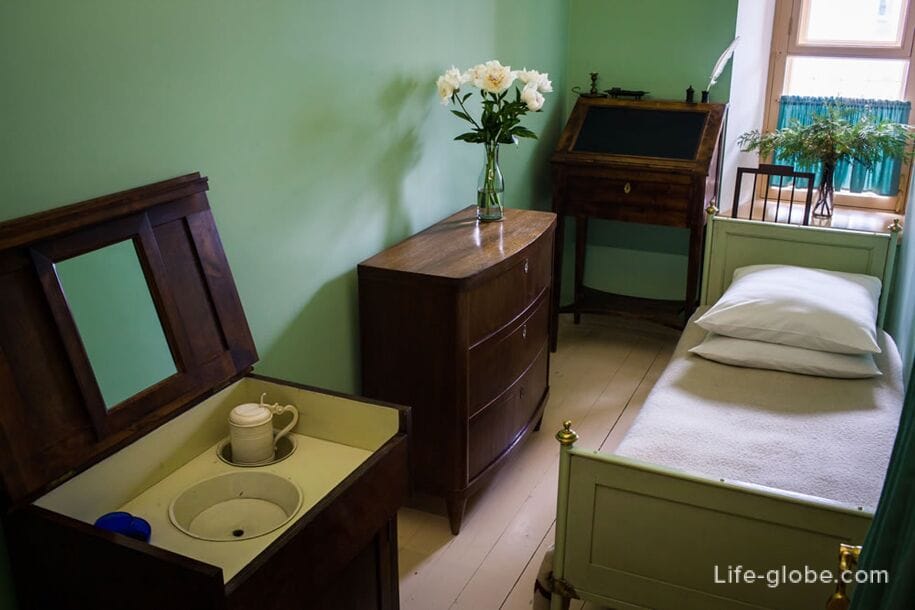
!!! The two above-mentioned museums (the Lyceum Museum and the dacha Museum) are part of the All-Russian Pushkin Museum, which is the oldest Pushkin Museum in Russia.
Website of the museum complex "All-Russian Pushkin Museum": museumpushkin.
Lyceum Garden
The Lyceum Garden is located next to Alexander Park and attracts guests with a monument to Alexander Pushkin and a small Znamenskaya Church, which was built in honor of the icon of the Mother of God of the Sign in 1734-1747 by the architect Mikhail Grigoryevich Zemtsov and his closest assistant Ivan Yakovlevich Blank, at the behest of Tsarevna Elizabeth Petrovna.
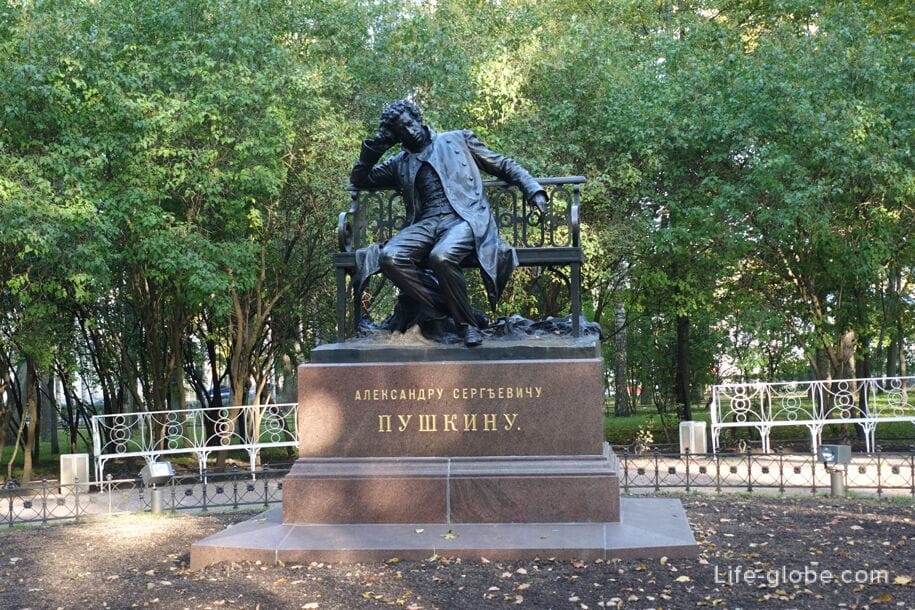

Cathedral Square with the Catherine Cathedral
Cathedral Square is the central square of the city of Pushkin.
The dominant feature of the square, located in its center, is the current Orthodox Cathedral of St. Catherine the Great Martyr with a museum. Learn more about the square, the cathedral and the museum…
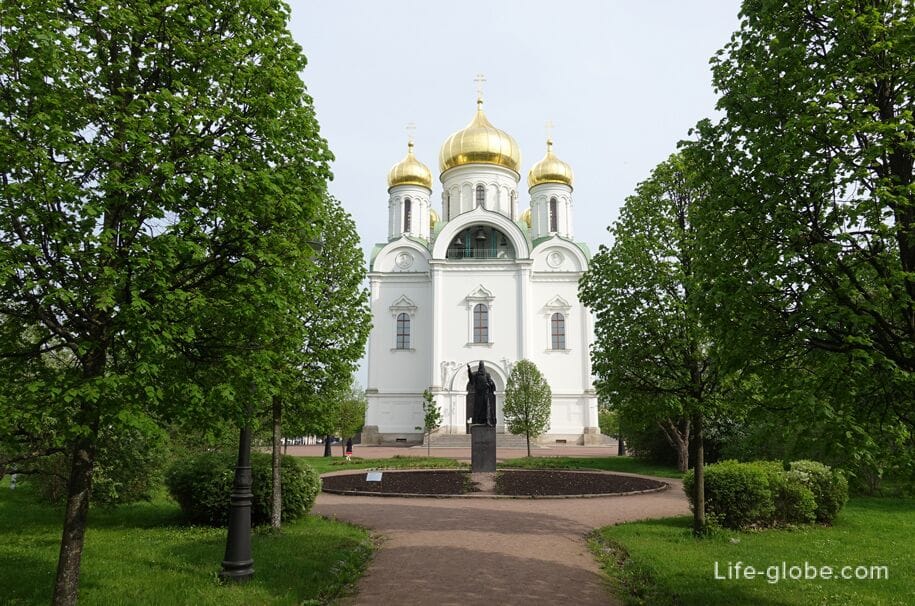

Gostiny Dvor Shopping Center
The Gostiny Dvor shopping center was originally made of wood and was founded in 1818 according to the plans of V. I. Geste.
In 1862, most of the wooden complex was destroyed by fire. The restoration of the Gostiny Dvor was carried out in stone. The building was opened for trade in 1866.
Today, as many years ago, the Gostiny Dvor complex continues to be used for trade.
The building has one floor. Its facades are decorated with an arched gallery. The general decor of the main building is complex, which brings it closer to the Baroque style.
From the courtyard side, the complex includes the so-called "Meat Rows" building (originally built in 1843-1844 by the architect N. S. Nikitin in stone), which has a semicircular shape and is decorated in the style of late classicism.
The address of Gostiny Dvoris 25 Moskovskaya Street.
Gostiny Dvor website: bc-gostiniydvor.
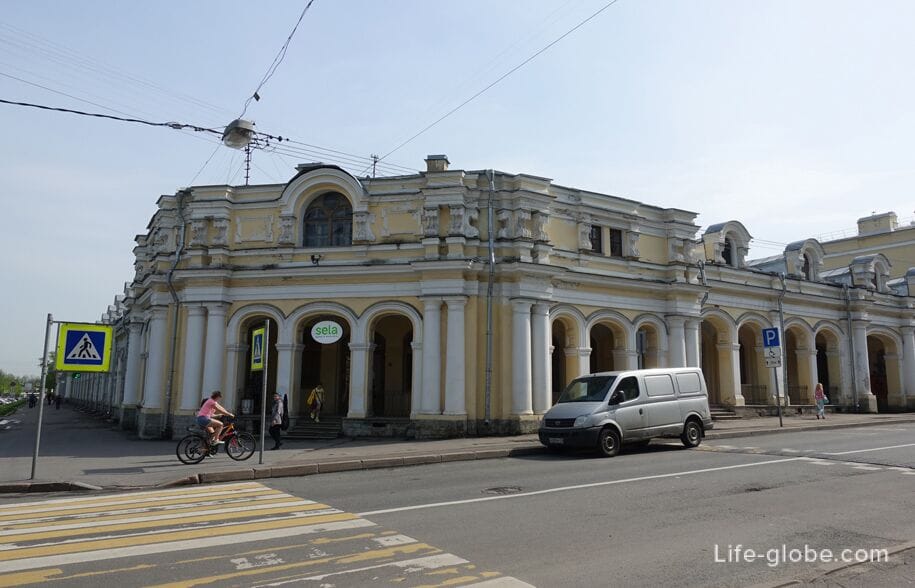
Mariinsky Women's Gymnasium
The building of the Mariinsky Women's Gymnasium appeared in the early 20th century.
Today, the House of Creativity of Young People is located in the walls of the building.
The address of the House of Creativity of youngpeople : Pushkinskaya Street, 28/21.
Website of the House of Creativity of youngpeople: pushkindt.spb.
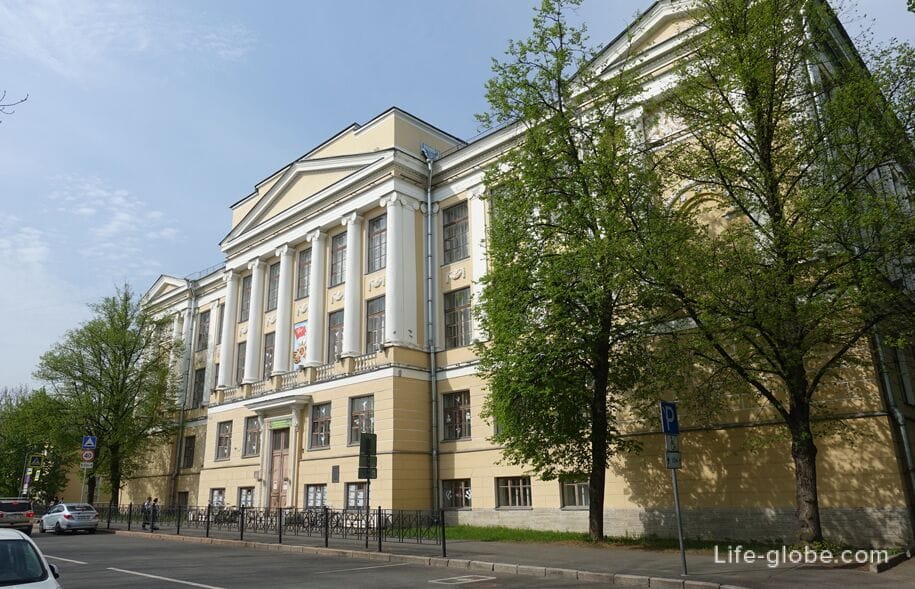
Monument to Catherine II
The monument to Catherine II, installed on a high granite pedestal, is located across Pushkinskaya Street from Cathedral Square.
The bronze sculpture was created by V.E. Gorev. It has a height of 2 meters and depicts the Empress.
The sculpture is an exact copy of the sculpture installed in 2002 in the city of Novorzhev.
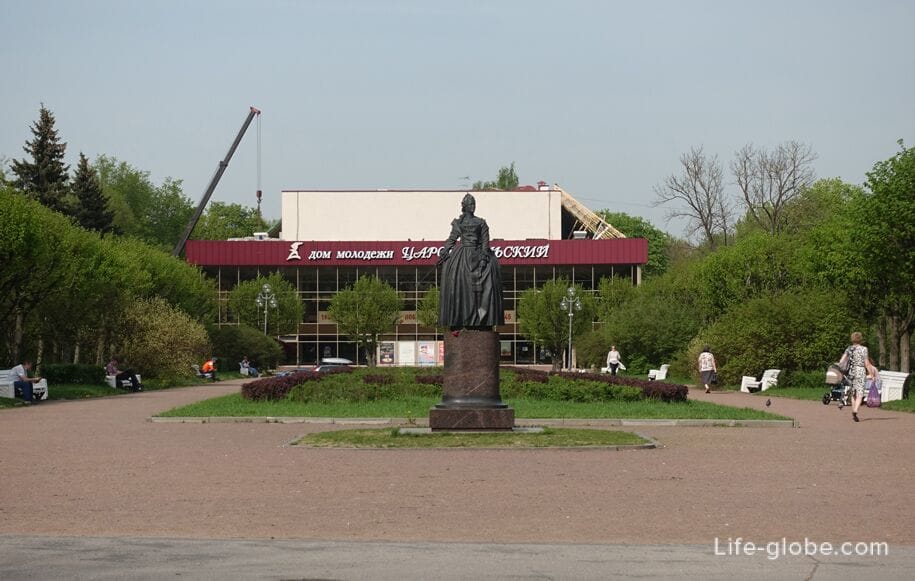
The building of the former city administration (Historical and Literary Museum of the city of Pushkin)
The building of the former city administration was originally intended to house the police with a fire tower.
The building was built in 1820-1822 according to the project of V. Geste, revised by V. P. Stasov, and was the first stone building of the square.
In 1908, the architect Silvio Amvrosievich Danini rebuilt the city administration building: the third half-floor was added, a large thermal window was added above the columns, the water supply and central heating system were designed, the tower was moved due to two more buildings facing the square, and several courtyard buildings.
In 1920, the buildings were transferred to the Detskoselsky (Pushkin) City Council of Workers 'and Peasants' Deputies and executive authorities.
During the Great Patriotic War, the buildings were damaged, then restored.
Now the military commissariat of the Pushkin district is located in the former house of the police chief's office, the fire station is still working next door (the building inside the courtyard), and the Historical and Literary Museum of the city of Pushkin is open in the building of the former city administration.
The address of the museum: Leontievskaya Street, 28.
Photo of the museum
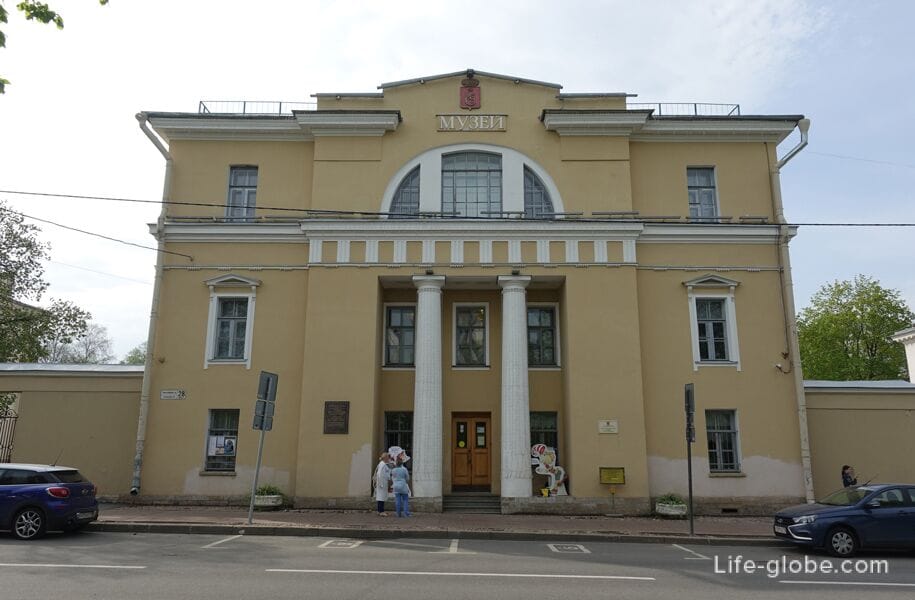
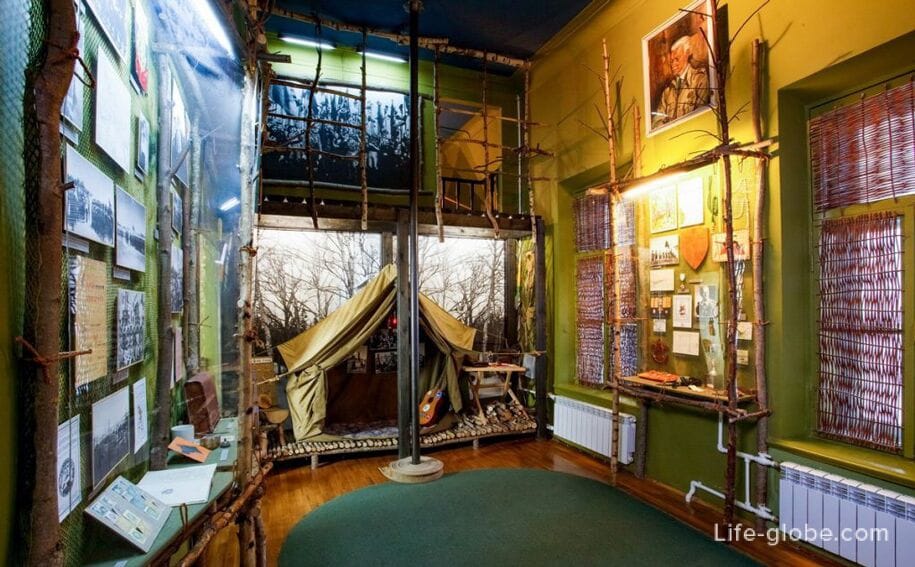
Photo of the fire station building (26 Leontievskaya Street)
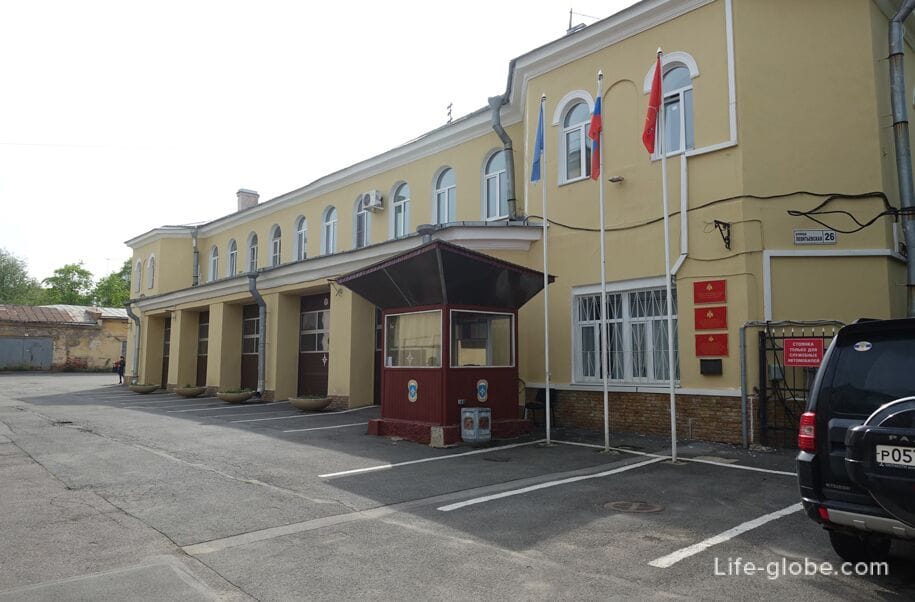
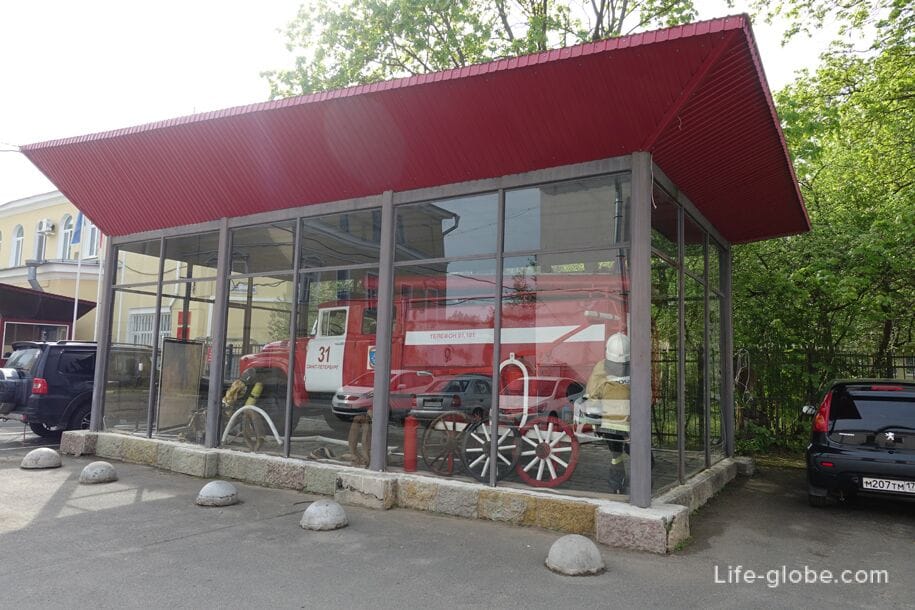
Moscow Gate with expositions "Tsarskoye Selo garrison"
The Moscow Gate is a historical monument and a triumphal arch dedicated to the memory of the events of the Patriotic War of 1812 in the city of Pushkin in St. Petersburg (Tsarskoye Selo).
The Moscow Gate was erected as a Triumphal Gate in 1829-1831 by the decree of Emperor Nicholas I, according to the project of architects V. A. Glinka (gate) and A.M. Gornostaev (guardhouse) with the participation of I. Hildebrandt.
The gates were erected in memory of the glorious victories of the Russian Army in the Patriotic War of 1812 and the military company of 1812-1814.
In the guardhouses of the gate there are expositions "Tsarskoye Selo garrison", dedicated to the history of the city outpost and the Tsarskoye Selo garrison.
The Moscow Gate is located at the intersection of the Moscow Highway and Sofia Boulevard. Learn more about the Moscow Gate with expositions…

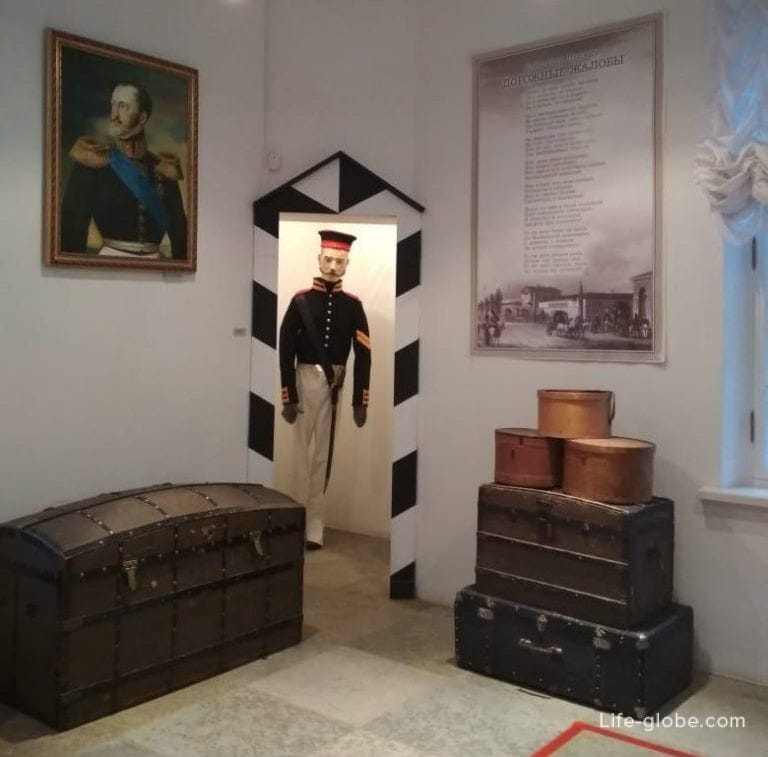
The two above-mentioned museums (the main building and the exposition in the Moscow Gate) are part of the Historical and Literary Museum of the city of Pushkin.
The website of the Historical and Literary Museum of the city of Pushkin: ilmp.ru.
The Tsarskoye Selo Collection Museum
The museum is located in a historic Art Nouveau building with Gothic elements, built in 1909 by architect Gustav von Goli and known as the Stetkevich House (after one of the former owners).
It is the State Museum of Modern Traditional Art, which includes a collection of works of the Leningrad and Moscow post-avant-garde of the 20-90s of the 20th century, preserving the traditions of pictorial and plastic realism.
Part of the permanent exhibition is dedicated to the artists of the Arefiev circle.
The museum regularly holds exhibitions of contemporary artists.
There is a painting workshop at the museum.
The address of the museum: 40 Shopeynaya Street / 27 Leontievskaya Street.
The museum's website: museumfa.
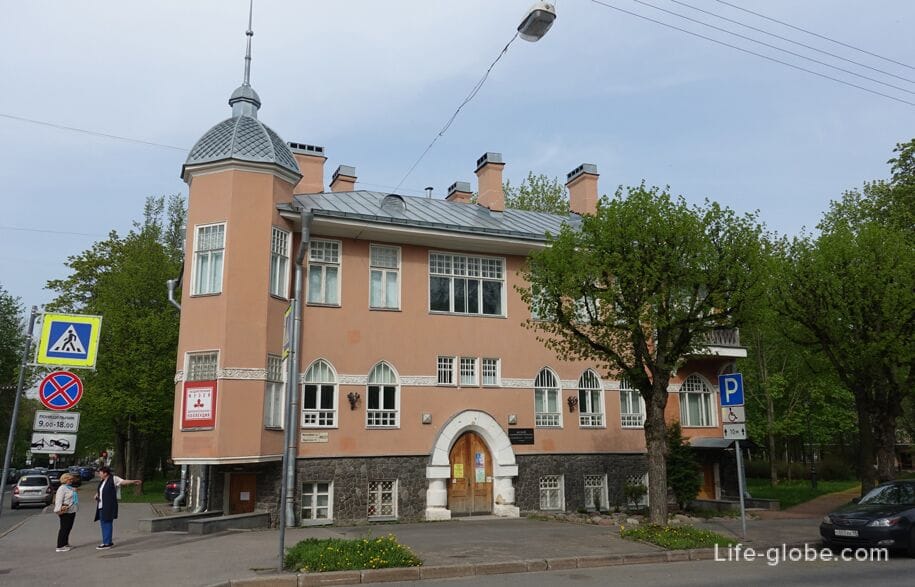
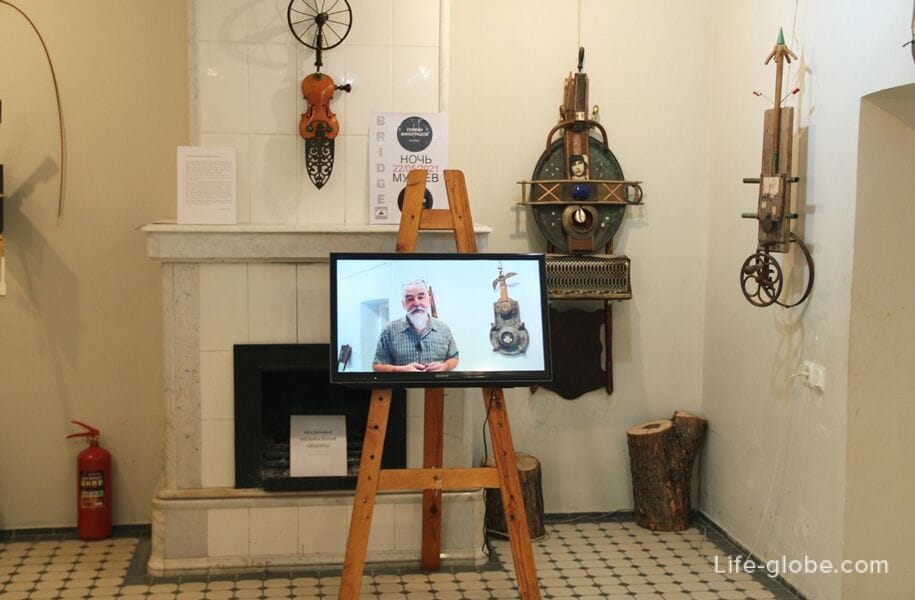
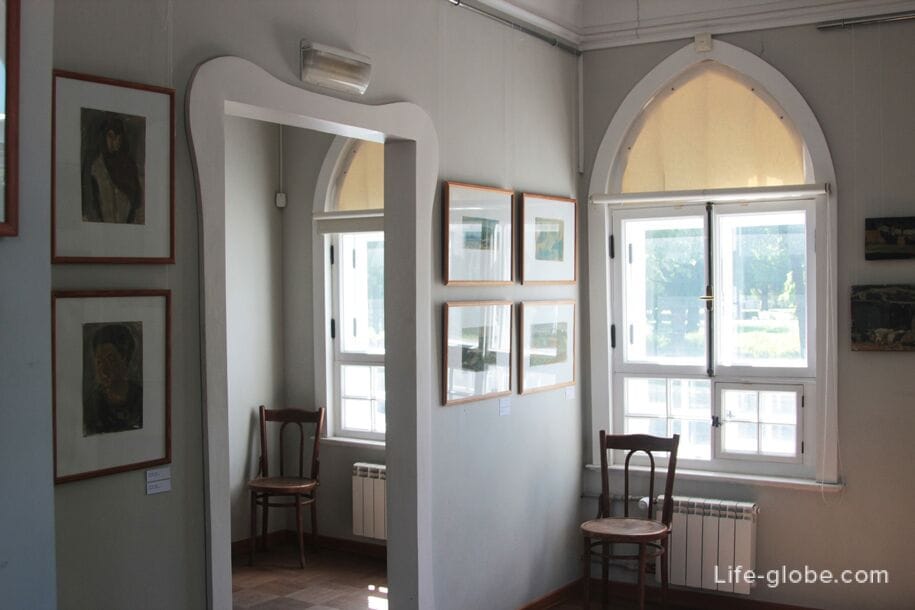
P.P. Chistyakov House-Museum
The museum is located in a house built in 1878 by the architect A.H. Kolb. The house is now a monument of Russian wooden architecture of the late 19th century.
Pavel Petrovich Chistyakov (1832-1919), a historical painter and portrait painter, professor of the Imperial Academy of Arts, who went down in the history of the Russian art school as a mentor and teacher of the greatest masters of Russian art, lived and worked in this house.
The museum presents paintings by Chistyakov, reflecting almost all periods of the artist's work. In a small hall dedicated to Chistyakov, a teacher, the works of his pupils from the funds of the Research Museum at the Russian Academy of Arts are shown.
The museum hosts traditional musical evenings and an annual celebration of the artist's birthday on the first Sunday of July. Exhibitions of works by contemporary artists are regularly held in the Corner or Small Living Room.
The address of the museum: Moskovskoe shosse, 23.
The museum is a branch of the Museum of the Academy of Arts. Website: artsacademymuseum.
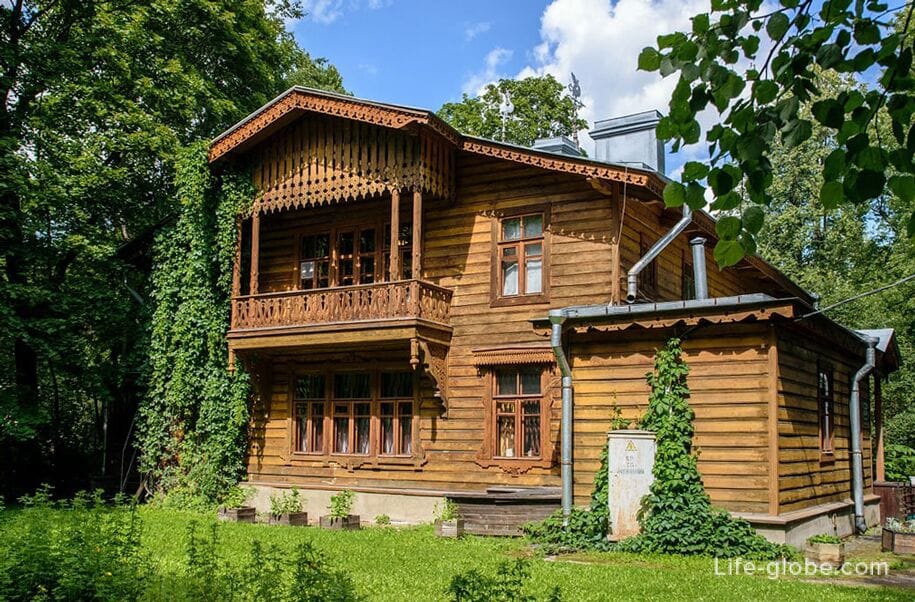
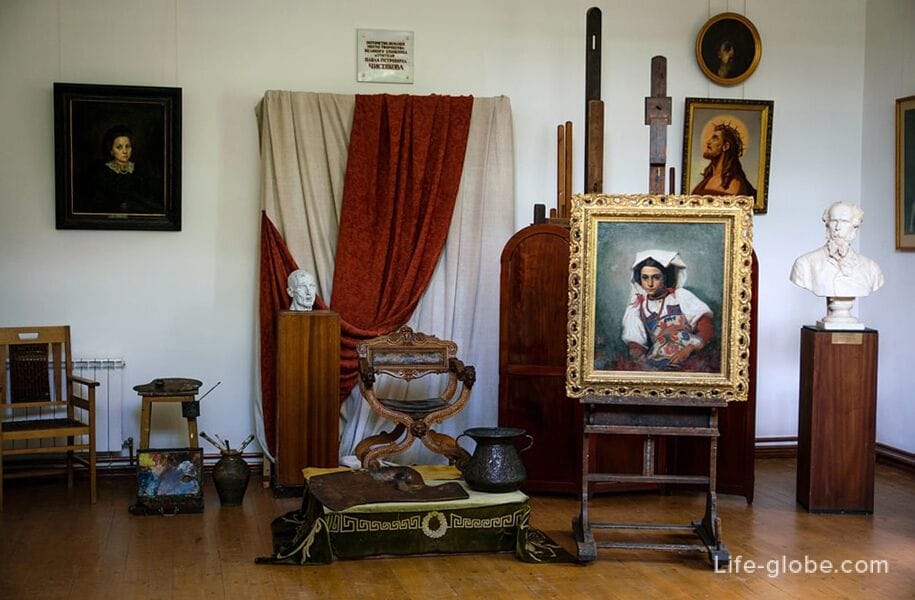
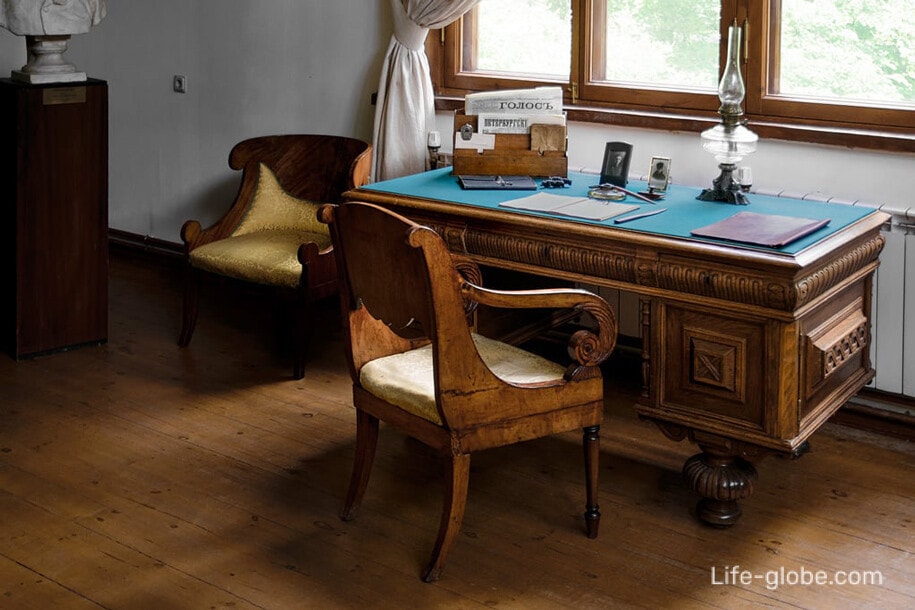
The exhibition "Anna Akhmatova Tsarskoe Selo"
The exhibition "Anna Akhmatova. Tsarskoye Selo" is located in the historical building of the former Mariinsky Women's Gymnasium-the Tsarskoye Selo Gymnasium of Arts named after A.A. Akhmatova.
The exhibition area is 110 sq. m. and is made on 18 tablets and in 16 showcases.
The exhibition presents: archival copies, authentic autographs of the poet, photocopies, authentic views of Tsarskoye Selo of the late 19th-early 200th centuries, fragments of poems by Anna Akhmatova and other exhibition rarities, as well as a marble bust of Anna Akhmatova, executed by a gymnasium teacher - sculptor Maxim Viktorovich Lapachugin.
The entire exhibition demonstrates the most important stages of the biography of A. A. Akhmatova, the creative path of the poet and the place that Tsarskoye Selo occupied in her life.
The address of the exhibition: 17 Leontievskaya Street.
Exhibition website: ekspozitsiya-tsarskoe-selo.
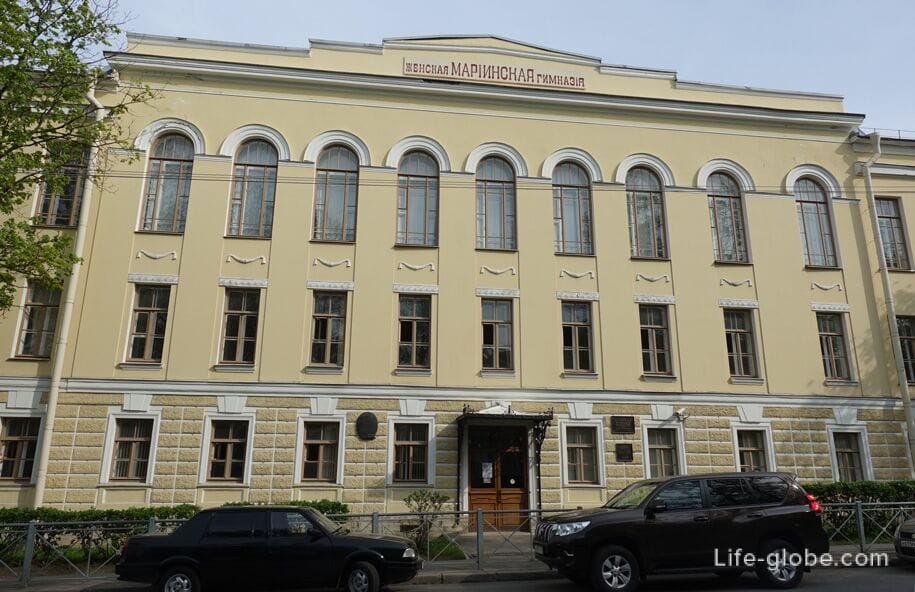
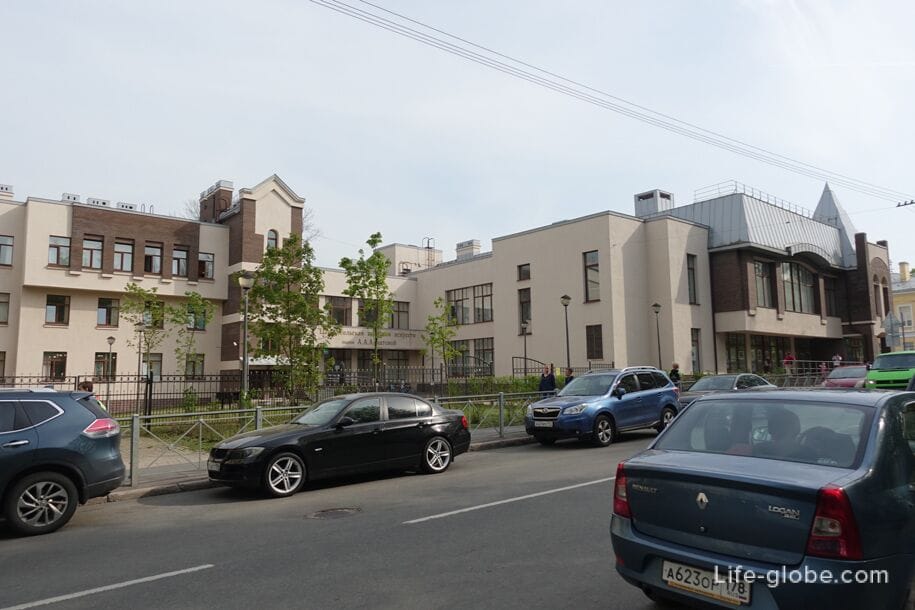
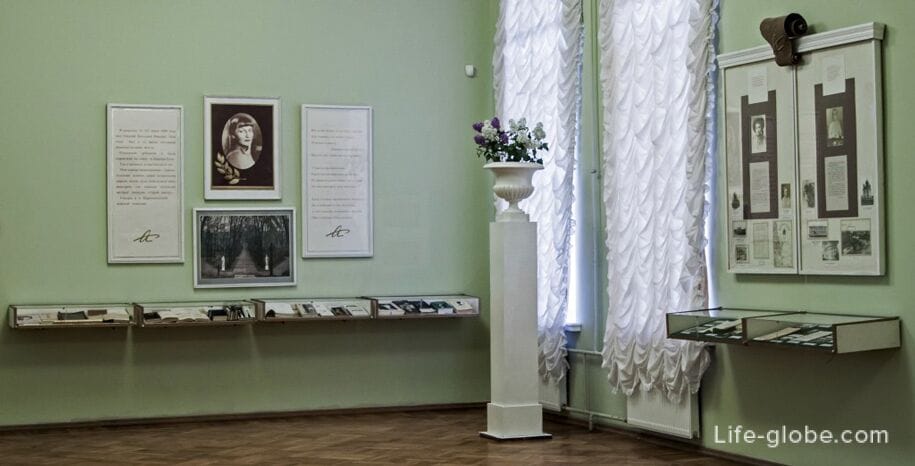
Lower ponds and the surrounding ensemble
Near the two Lower Cascade Ponds, which are adjacent to the Catherine Park and are part of the five Lower Ponds (three of which are located on the territory of the Catherine Park), there are small green areas with walking paths.
The ponds were formed in the early 18th century thanks to dams built on a small stream. In the middle of the 18th century, the ponds received a regular shape, and in 1775-1778, under the leadership of engineer I. K. Gerard and architect V. I. Neelov, work was carried out to strengthen and deepen the ponds, the banks of which were given natural outlines. Bridges between ponds are bridges-dams.
The two Lower ponds stretch from Sadovaya Street (Pavlovskaya Dam). The ponds are called Jordan and Kupalny. The ponds are separated by a bridge-dam across Sovetsky Lane (Sovetskaya / Pashkovskaya Dam).
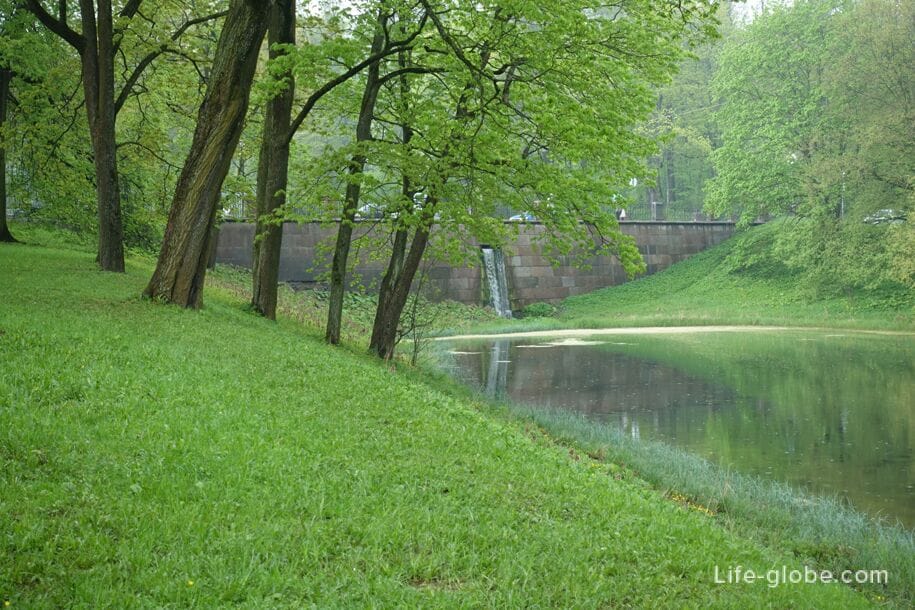
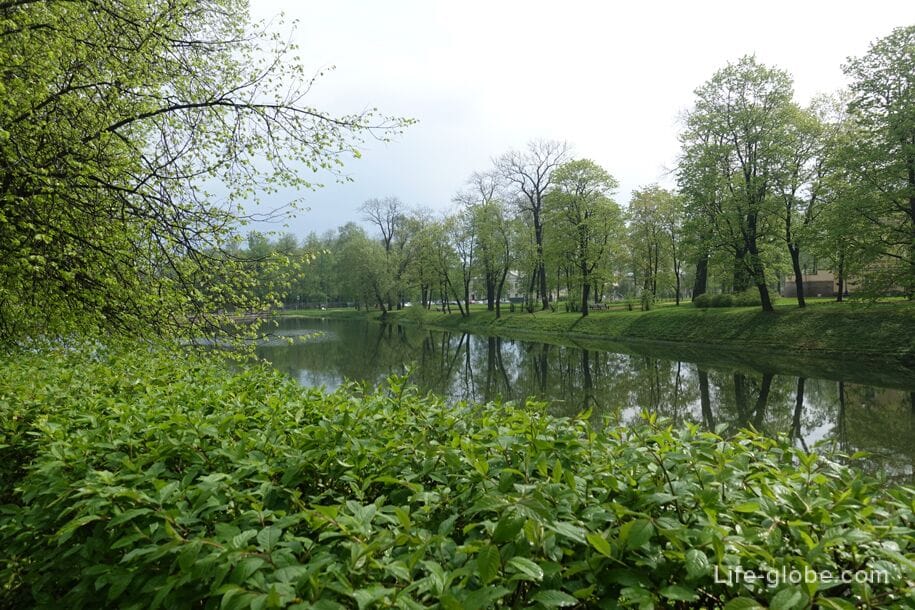
There are several significant sights of the city on the shores of the ponds: Pushkin House of Culture (Concert Hall), Evangelical Lutheran Church of the Resurrection of Christ with a museum and Wedding Palace (formerly Reserve Palace / Kochubeya).
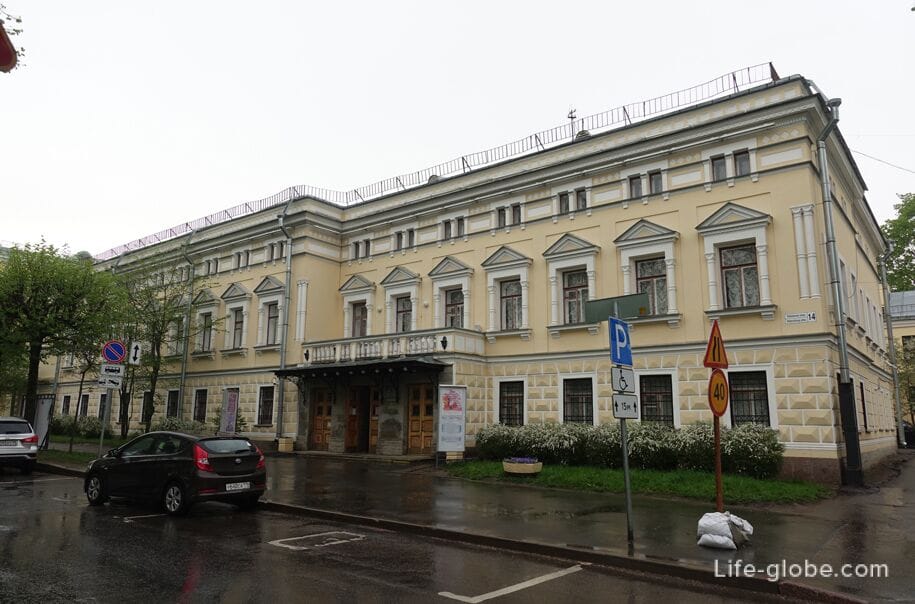
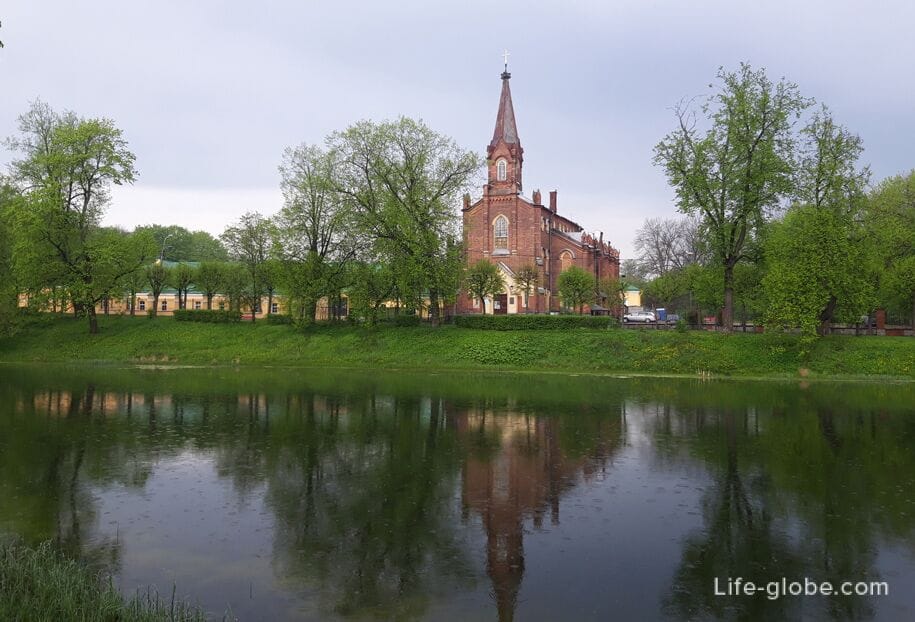
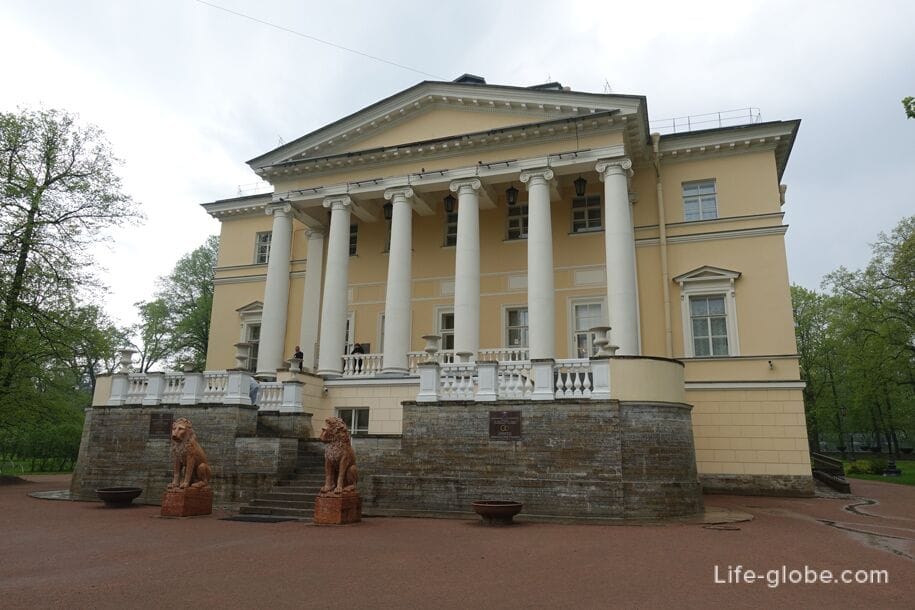
Monument to Ernest Telman
The bronze monument to the German communist-anti-fascist Ernest Telman is installed on a high granite pedestal, at the address: Sofia Boulevard, 11.
The grand opening of the monument took place on May 8, 1960. His daughter Rosa Telman was present at the opening. The monument was presented by the metallurgists of the city of Eisleben in memory of the monument of V. I. Lenin preserved by the German anti-fascists, taken from the city of Pushkin to be melted down in Germany during the occupation.
Sculptor Walter Arnold; architects Levinson Evgeny Adolfovich and Golynkin Oleg Borisovich.
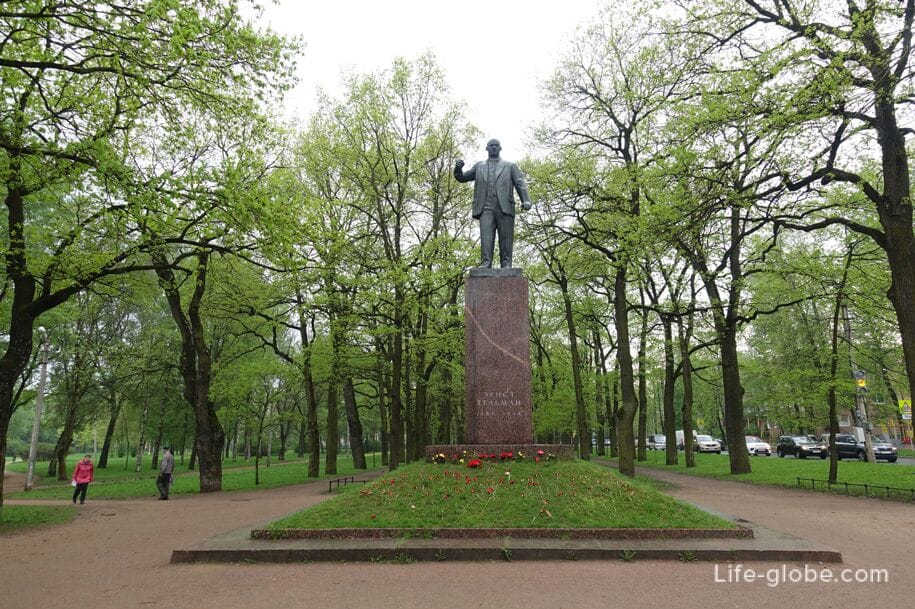
Panteleimon Church
The church is located in the former hospital chapel and is the heir of the hospital church, which was gradually moved here from Sofia.
In the middle of the 19th century, a chapel was built in the hospital courtyard, in which an old iconostasis from the field church of Catherine I was installed. In the chapel there used to be the altar of the field church, which was moved in 1872 to the Tsarskoye Selo Gymnasium Church.
The chapel was used as a mortuary, funeral services were performed in it.
In 1907-1908, the building was partially rebuilt and expanded according to the project of the architect S. A. Danini.
The body of the murdered Archpriest John Kochurov was in the chapel for some time.
The chapel was closed in 1929 and was used as the city morgue until 1999.
In 2000, the chapel was returned to the Russian Orthodox Church, and restoration began in it. In 2001, it was consecrated as a church in the name of the Holy Great Martyr Panteleimon.
The address of the temple: 7/2 Hospital Street, letter E.

St. Sophia (Ascension) Cathedral
With the foundation in January 1779 of the district city of Sofia (now a historical district in the southern part of the city of Pushkin) Russian Russian Empress Catherine II intended to build a memorial church in honor of the Russian victories in the Russo-Turkish wars. According to the plan of the times of the "Greek project", the temple was supposed to resemble St. Sophia Cathedral in Constantinople.
The consecration of the church took place on May 20 (31), 1788 in the presence of Catherine II, the heir and the courtiers. The design and construction works were supervised by the Scottish architect Charles Cameron, together with whom Ivan Yegorovich Starov worked.
In 1933-1934, the cathedral was closed, and the building was transferred to the 32nd Mechanized Brigade, which used it as a warehouse.
On March 13, 1988, the church was transferred to the church community. On June 8, 1989, on the patronal feast of the Ascension of the Lord, the first liturgy was served.
Subsequently, the cathedral was restored.
The address of the cathedral: Sofia Square, 1.
The cathedral's website: sophia-sobor.
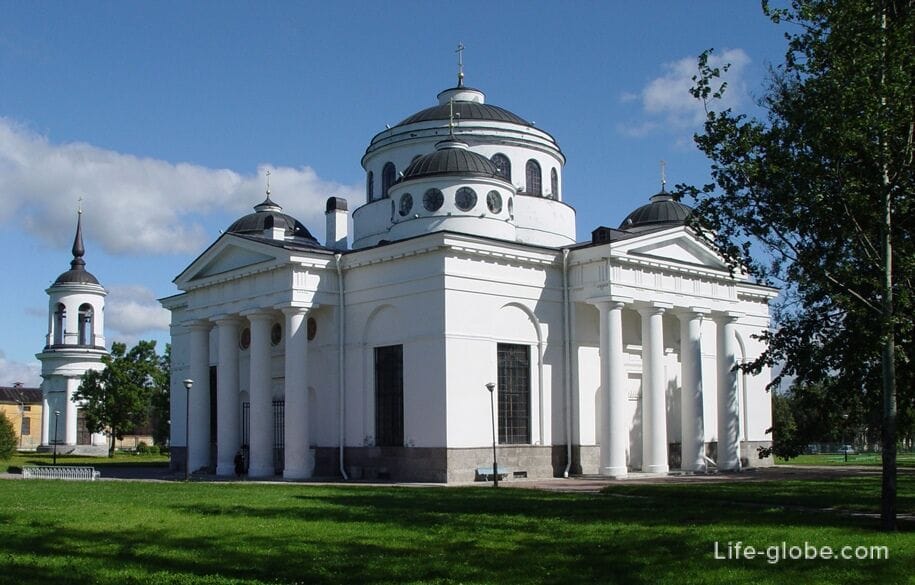
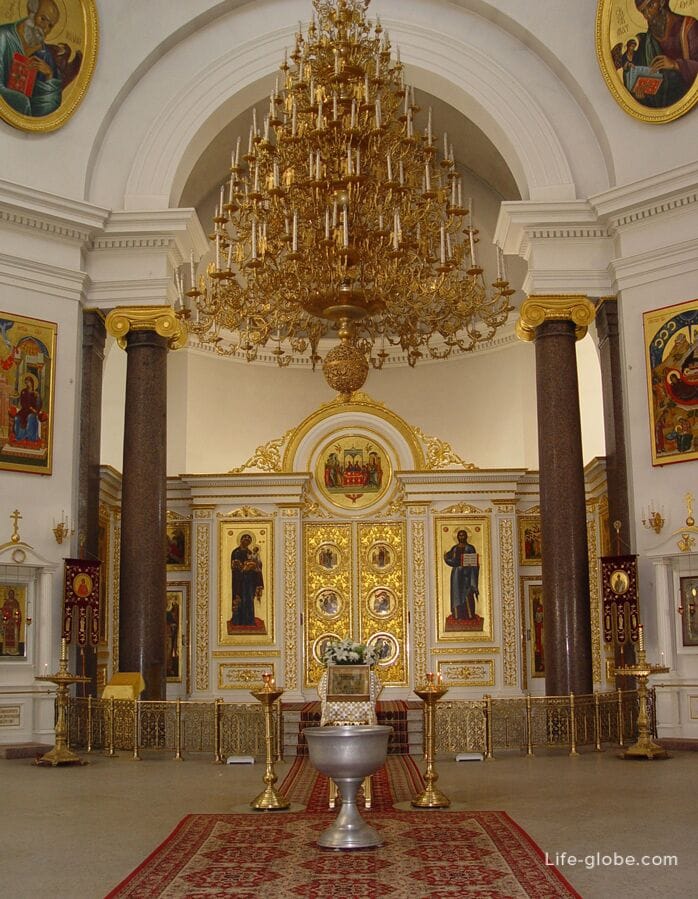
Monument "Formula of Sorrow"
The "Formula of Sorrow" is a monument dedicated to the Jews who became victims of Nazism, who were shot in Pushkin during the Second World War.
1972, 1991, sculptors V.A. Sidur, A.V. Pozin, architect B.H. Bader.
Address: square at the intersection of Dvortsovaya and Moskovskaya streets.
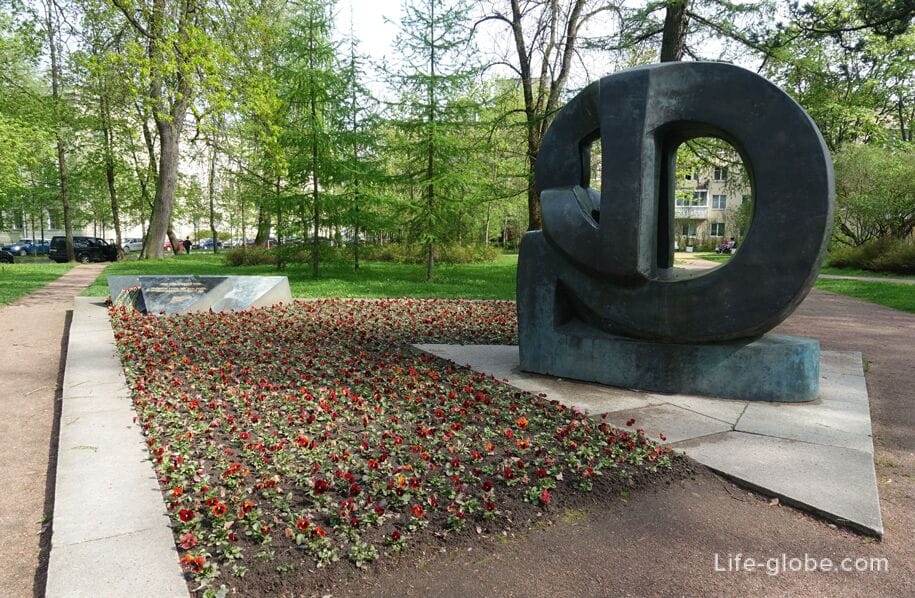
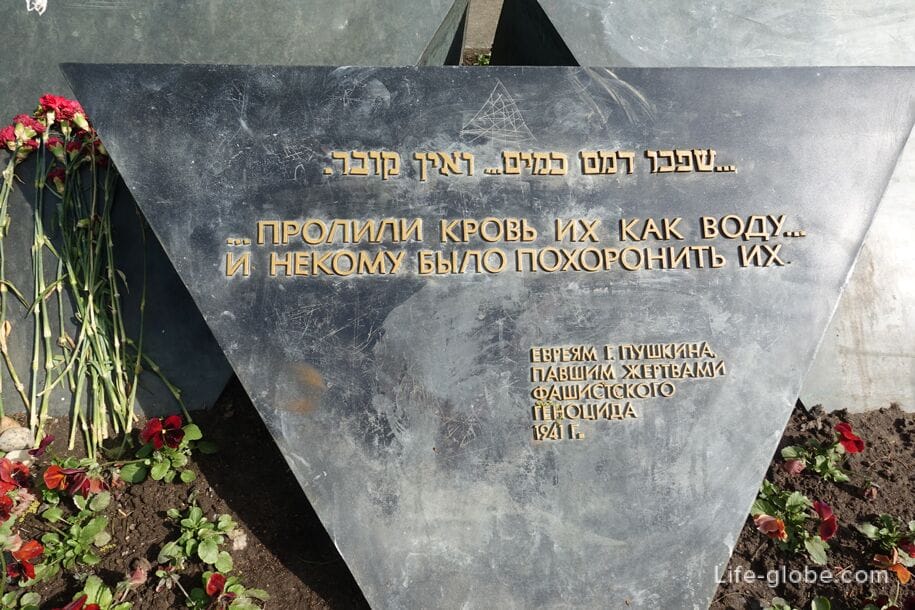
Egyptian (Kuzminsky) gates
The Egyptian Gate was built in the Egyptiizing style in 1827-1830 at the entrance to the Alexander Park of Tsarskoye Selo from the side of the former Bolshoe Kuzmino (Pushkin) settlement, designed by the Scottish architect Adam Adamovich Menelas. The project of the gate was approved by Emperor Nicholas I.
One of the gate towers was residential until 1985, V. V. Ignatov, who worked as a watchman at the Leningrad Agricultural Institute, lived in it (until his death).
The gate is located at the intersection of Dvortsovaya (formerly Kuzminskaya) Street, Oktyabrsky Boulevard and St. Petersburg Highway.
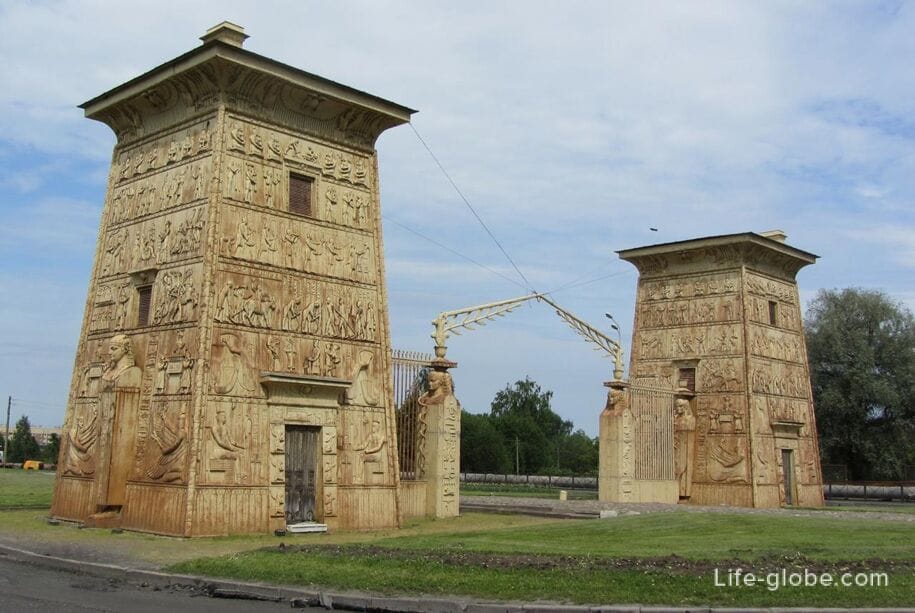
Flora Fountain
The fountain "Flora" (or "Goddess of Fertility", also known as "Savage") is a monument of fountain sculpture of the mid - 19th century.
The sculpture of the fountain "Flora" (the ancient Greek goddess of fertility) was cast at the St. Petersburg factory of Franz Karlovich San Galli in the 1850s.
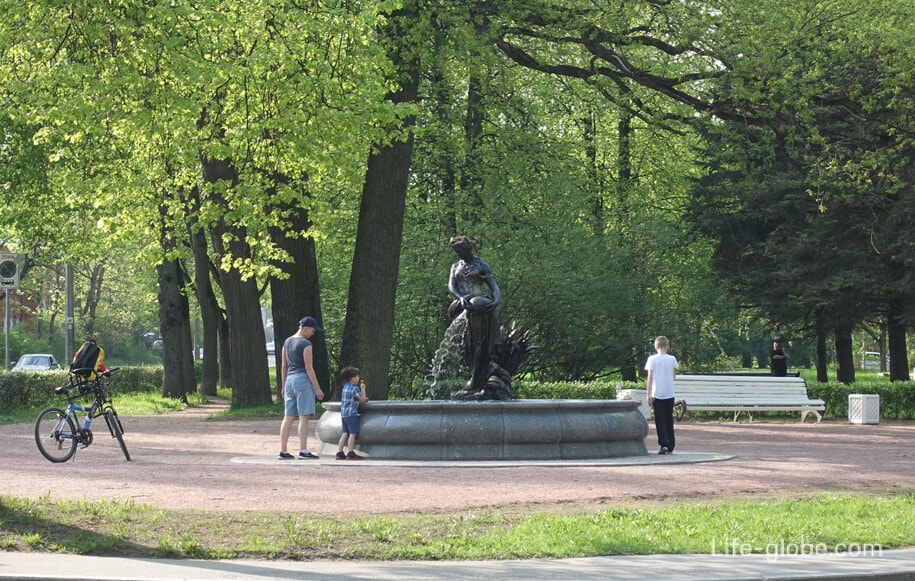
Babolovsky Park
Babolovsky Park is located between the southern part of the city of Pushkin and Alexandrovskaya.
Today Babolovsky Park is a public park with natural vegetation.
The main attraction of the park is the Babolovsky Palace-a bath pavilion of ten rooms, built in 1785 in the "Gothic taste" for Grigory Potemkin.
The palace is best known for its monumental granite bath-the "Tsar Bath", created by Samson Sukhanov in the 1820s.
The Babolovsky Palace was destroyed at the end of the Great Patriotic War, and is currently in a ruined state (restoration work is underway, the approximate completion date is October 2028).
Coordinates of the Babolovsky Palace: 59°42'31.0" N 30°20'39.0" E (59.708611, 30.344167).
The entrance to the park is free (free of charge).
Babolovsky Park is part of the State Museum-Reserve "Tsarskoye Selo".
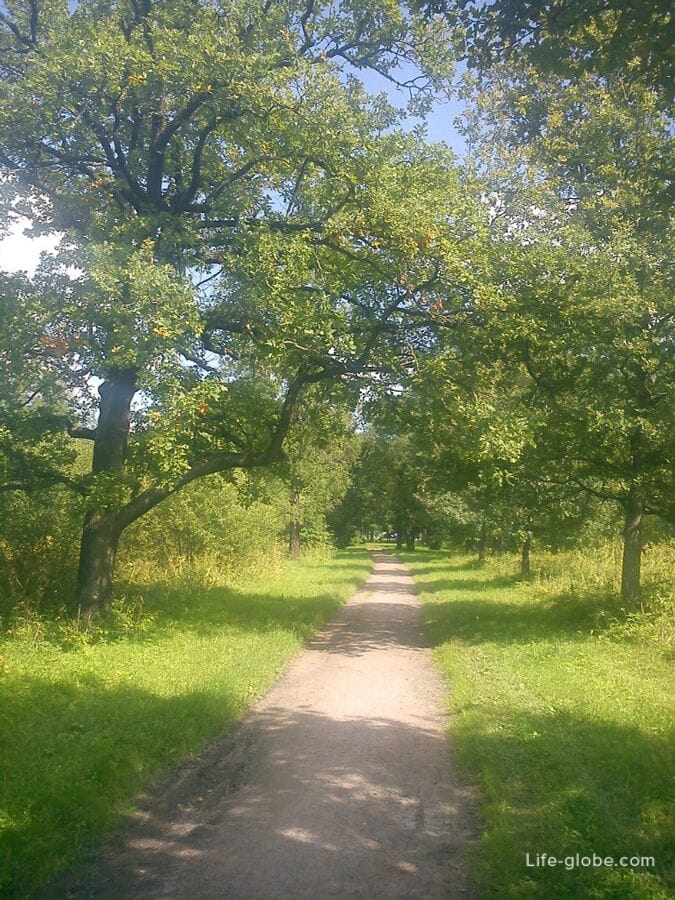
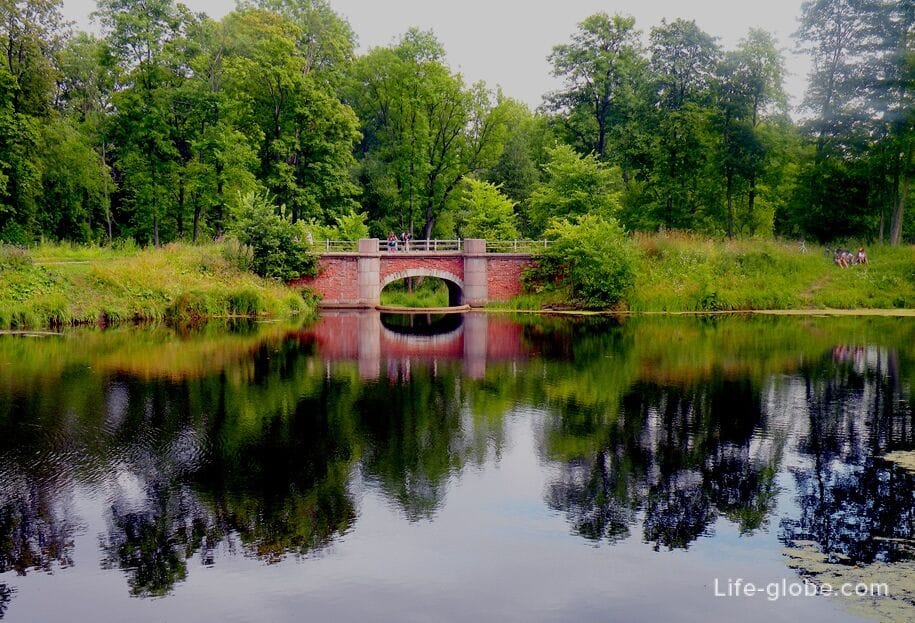
Separate (Lower) park
The park is also known as Kolonistsky, because it is located near the Kolonistsky Pond.
The background of the park is connected with the creation of a Colonist pond, which was dug in 1824-1825 by the Scottish architect Adam Adamovich Menelas to drain the area.
The park near the pond was laid out in 1830-1840.
The name" Separate " park was given because it is located separately( separately, independently) from other Tsarskoye Selo parks that are adjacent to each other (Catherine, Alexander and Babolovsky parks).
There are walking paths through the park. In summer, picnics are arranged in the park, people walk and swim in the pond, and on snowy winter days they go skiing.
The lower park begins on the left side of Sofia Boulevard and extends to Pavlovsk.
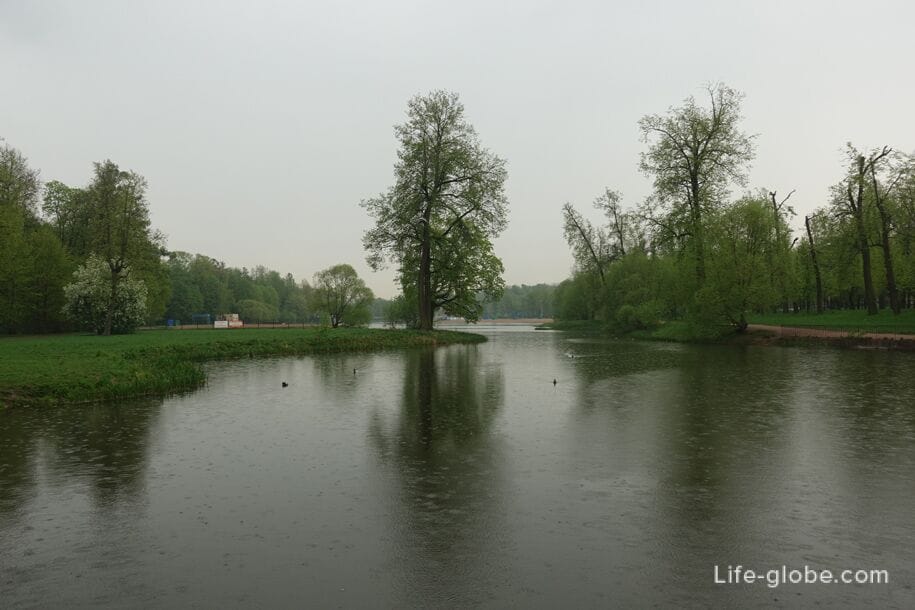
Buffer Park
Buffer Park is the city's and the youngest of Pushkin's parks.
The park was created in the late 1980s and early 1990s.
It consists of green meadows with trees and five ponds; a grove of the 300th anniversary of Tsarskoye Selo and the remains of the "Imperial Way" bridge, which was once located on the territory of the future park.
The buffer park is located at the entrance to Pushkin, from the side of the Petersburg highway.

St. John the Baptist Catholic Church
The Catholic Church in Pushkin, built in 1825-1826 by the architects Leone and Domenico Adamini. The construction of the temple was also carried out with the participation of V. P. Stasov. The land plot for the temple was allocated by Emperor Alexander I.
In 1906-1908, the building was expanded according to the project of S. A. Danini (with the participation of engineer I. F. Pentkovsky).
In April 1938, the church was closed, and the building was converted into a sports hall. Those buried in the church crypt were reburied at the Kazan Cemetery.
The church building was damaged in the Great Patriotic War, after it was restored and transferred to the state museum-reserve "Tsarskoye Selo" for a concert hall.
The first divine service in modern times was held in the church on March 17, 1991. On July 24, 2006, the building was completely returned to the Catholic Church, and the church was restored.
The building is built in the classical style. The portico of the main facade is designed in the form of a colonnade. The temple is crowned with a high dome with a cross.
The church's addressis 15 Dvortsovaya Street.
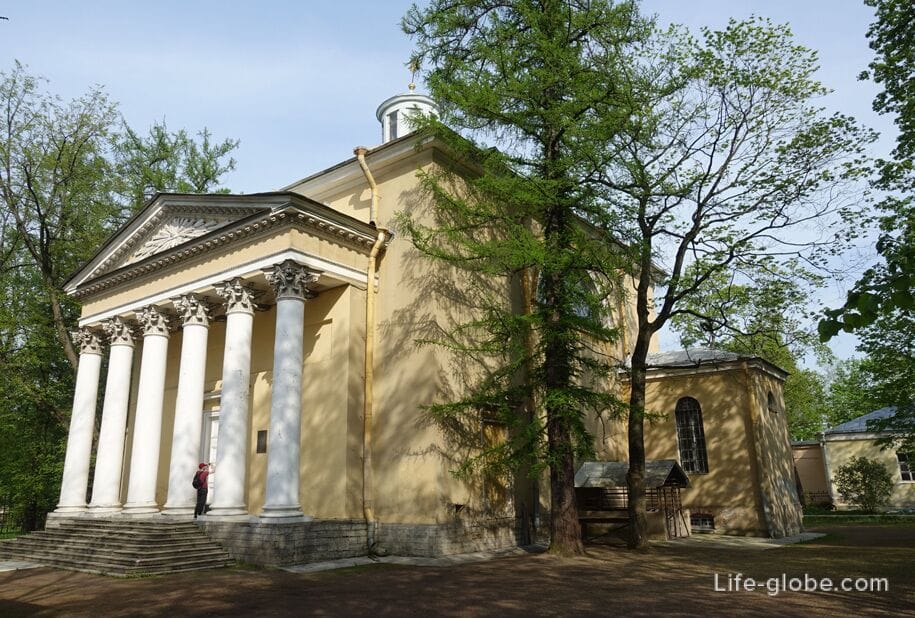

Railway Station building (Tsarskoye Selo station)
The Tsarskoye Selo station was opened as part of the first Tsarskoye Selo Railway in Russia and was the final station from St. Petersburg until May 22, 1838.
The first station building in Tsarskoye Selo was built on the border of the city in 1837 by the architect G. Fossati in the English Gothic style. Then, in 1902-1904, a new station building was built on the site of the station according to the project of a group of architects led by S. A. Brzhozovsky. The station was destroyed during the Great Patriotic War.
The modern building of the Tsarskoye Selo railway station was built in 1946-1950 by the architect E. A. Levinson. The station is a complex consisting of a main two-story building and three pavilions placed in one line with it.
Today it is a station of the Oktyabrskaya railway in the city of Pushkin.
Station address: Privokzalnaya Square, 1.
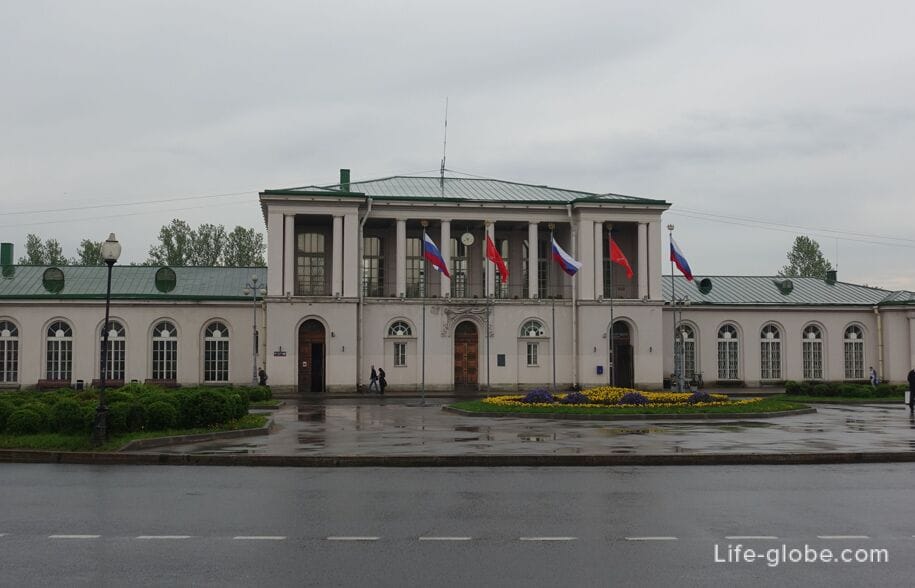
Other historical buildings in Pushkin
The building of the former Court Arena, built in 1786 by architect I.V. Neelov. It was rebuilt in 1819-1820 by architect V.P. Stasov. The court arena was intended for equestrian exercises by officers of the retinue and the imperial convoy, as well as regiments of the Imperial Guard, who were stationed in Tsarskoye Selo.
Today, the building of the court arena is an extended one-story structure, the center of which is decorated with a Doric columned portico. Loggias are located at the ends of the longitudinal facades of the building. The windows are semi-circular. The facades are decorated with a frieze with triglyphs.
The building is located on Sadovaya Street, 16 / at the corner with Konyushennaya Street, 2.
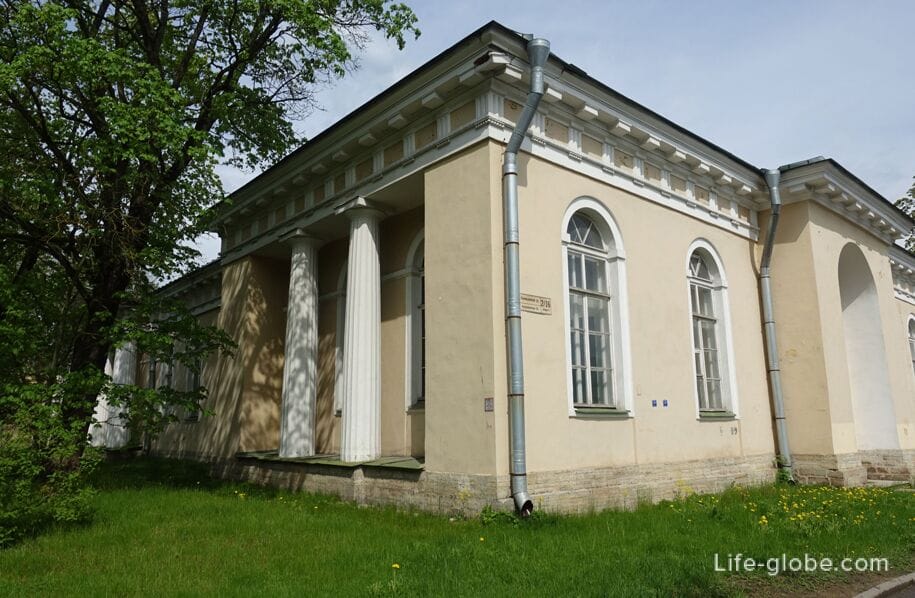

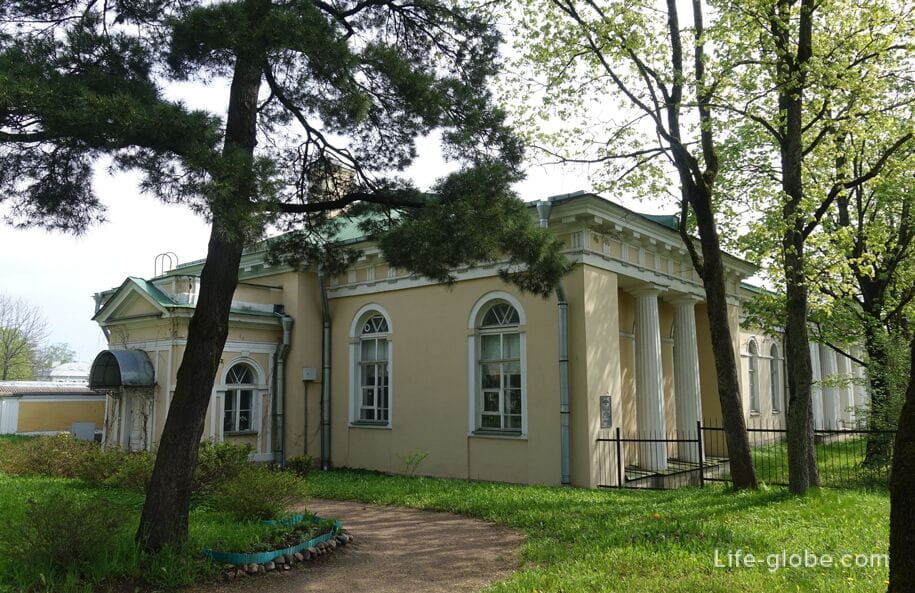
A large stone greenhouse, which was originally built of stone according to the project of the architect S. I. Chevakinsky. The rough construction was completed in 1753.
The new building of the greenhouse, on the site of the already dilapidated "old" one, was rebuilt by V. P. Stasov in 1820. Later, the building was expanded and consisted of several buildings.
The addressof the greenhouse : Sadovaya Street, 14 / Leontievskaya Street, 1 / Orangereynaya Street, 2.
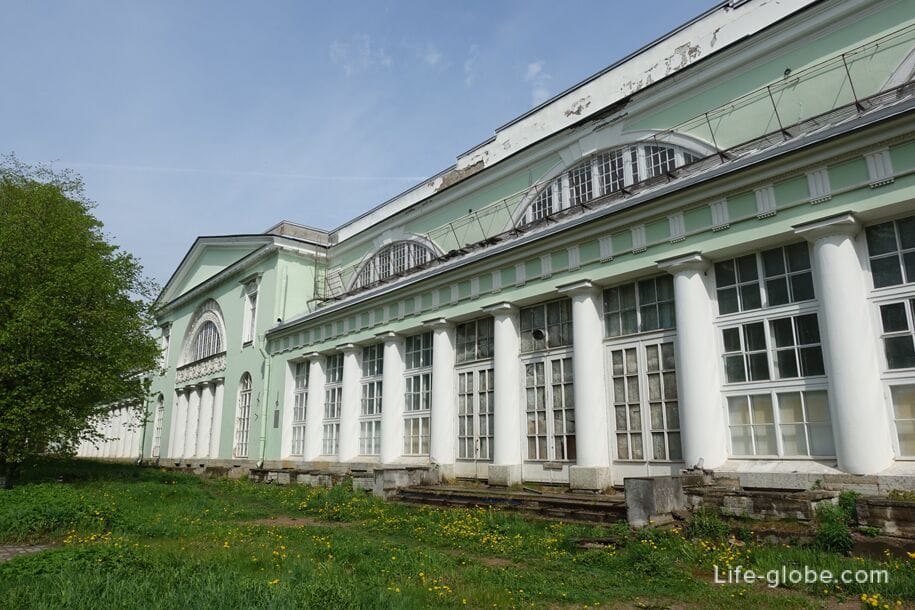
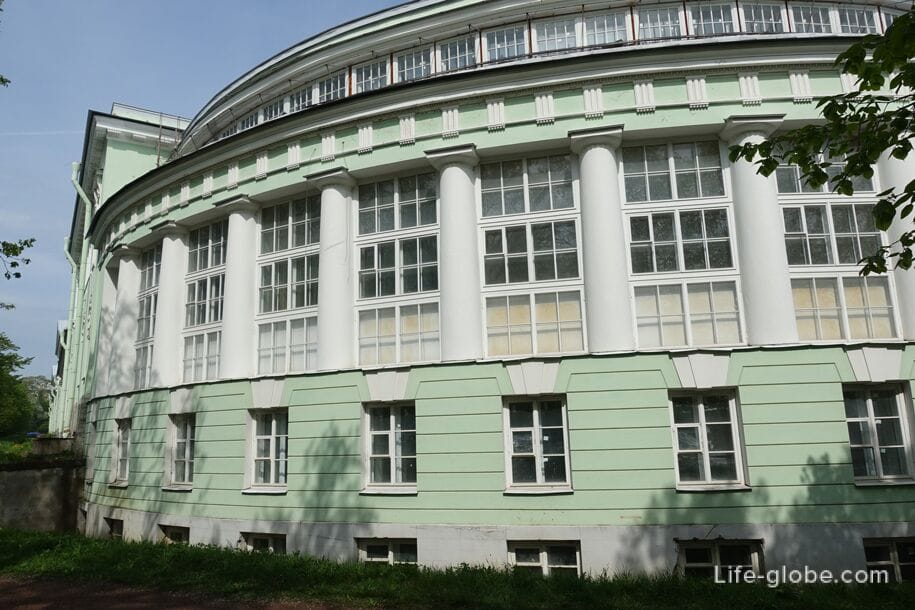
Cavalier Headquarters-the medical house, also known as the house of Karamzin.
Initially, the cavalier residential buildings on Sadovaya Street were built by decree of the Empress Elizabeth. The houses were intended for the manager of the Village of Sarsky and for visiting "gentlemen cavaliers".
One of the houses (the fourth Cavalier, or Staff-doctor's House) was provided by the order of Alexander I at the disposal of the historiographer Nikolai Mikhailovich Karamzin. Karamzin lived in the house from 1816 to 1821.
The address of the house: Sadovaya Street, 12 / Leontievskaya Street, 2.
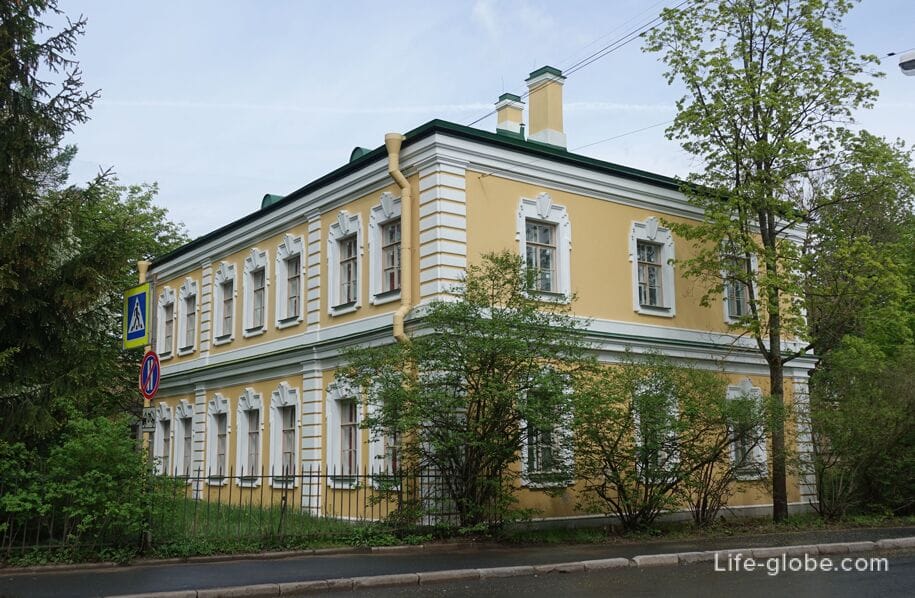
Former houses of palace servants. Even under Ekaterina Alekseevna, the owner of the first stone chambers (palaces) of Tsarskoye Selo, a settlement of palace servants appeared near them, where there were houses intended for servants of the imperial court. For the construction of the service and economic complex of the palace, a block was allocated between the "first and second" lines of the service settlement (now Sadovaya and Srednaya streets).
Thus were erected: one of the cavalier houses, in which the director of the Tsarskoye Selo Lyceum later lived; the so-called Singing Wing, which housed the Tsarskoye Selo palace administration and the house of the Tsarskoye Selo palace administration.
The houses are located on Lyceum Lane (on the odd side).

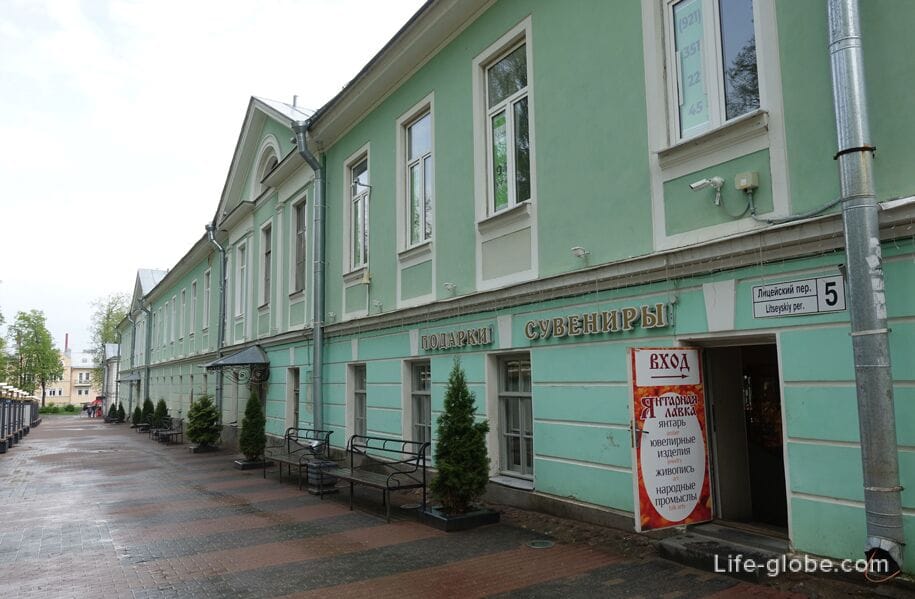
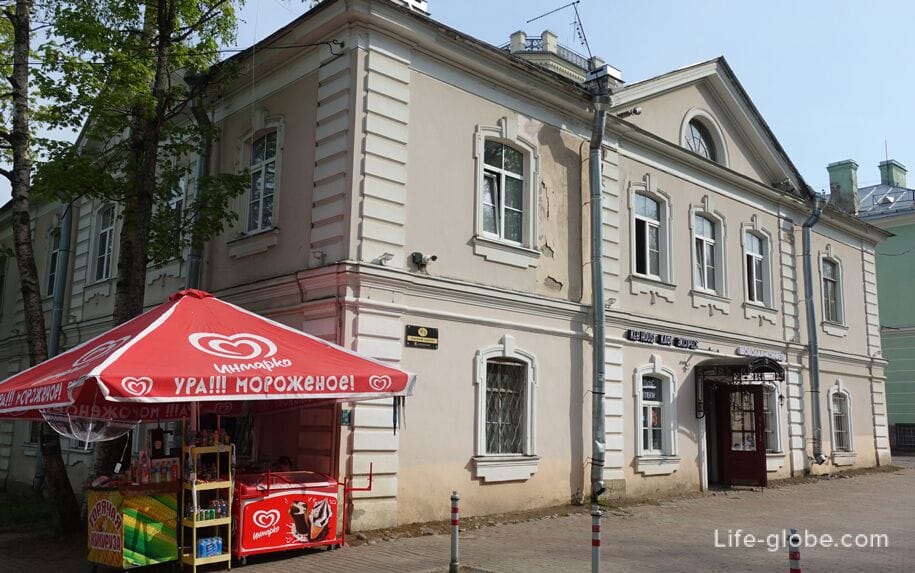
The estate of M. N. Patkul, which is a wooden house with elegant facades and a tower, made in the eclectic style.
The building was built in 1852 according to the project of I. A. Minigetti.
The house belonged to the family of the Lieutenant General of the member of the Military Council of the childhood friend of Emperor Alexander II-A.V. Patkul.
The address of the house: 8 Srednaya Street.
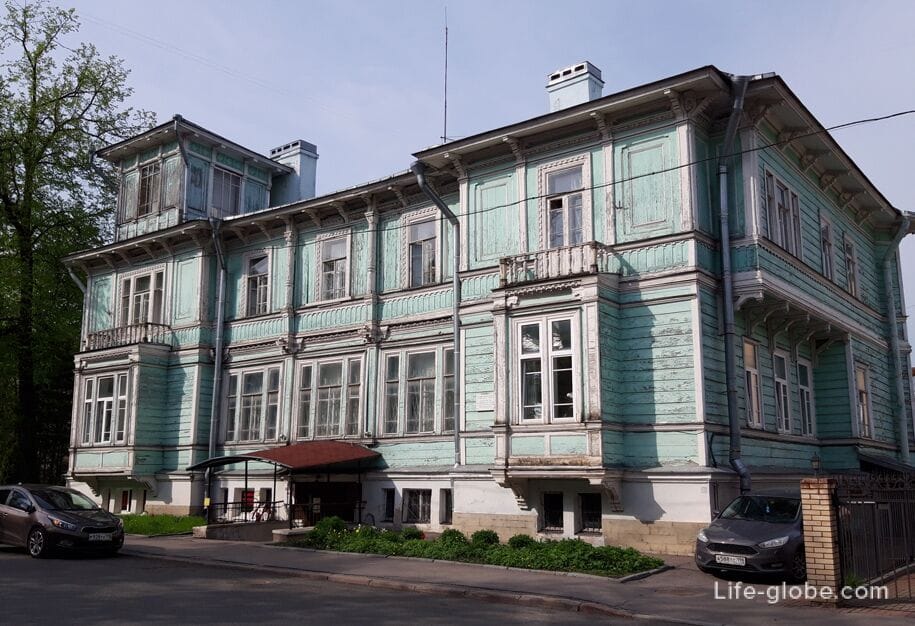
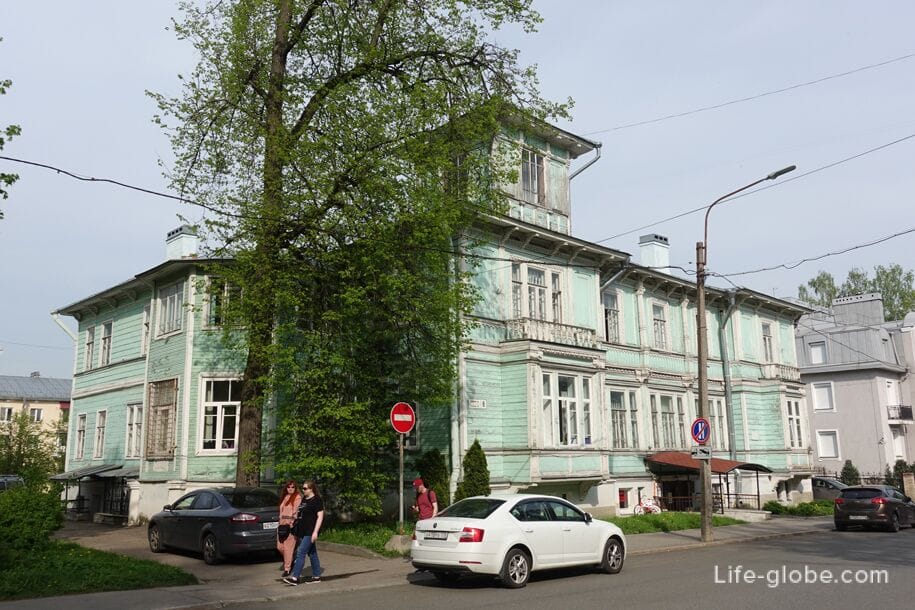
The wing of the estate, the house of M. A. Patkul is located on Malaya Street, 13. The building was dismantled in 2012 and then recreated.
Today, the 3-star Dom Patkul Hotel is located within the walls of the building with free Wi-Fi, a 24-hour front desk, room service, private parking and rooms with a kettle, a hairdryer and a flat-screen TV. Link to the hotel
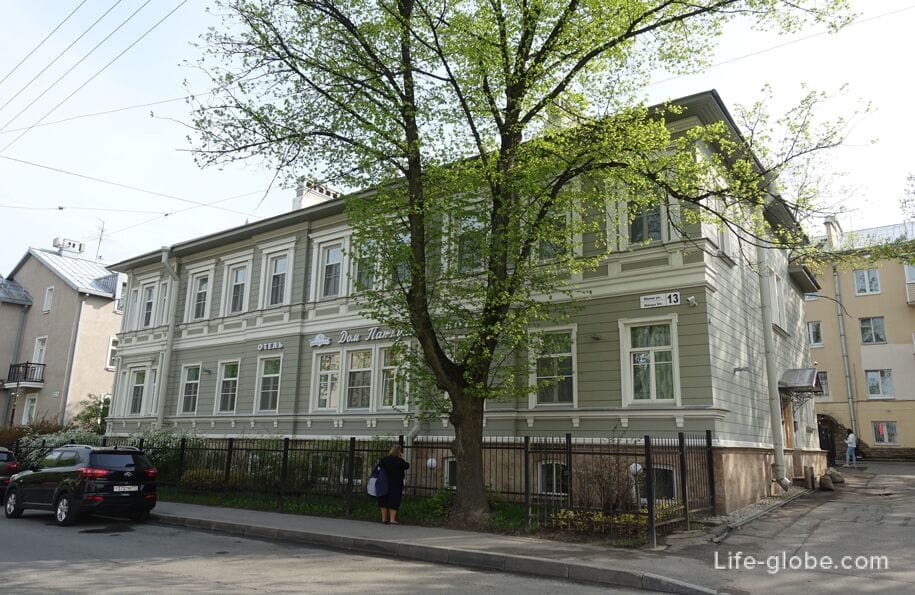
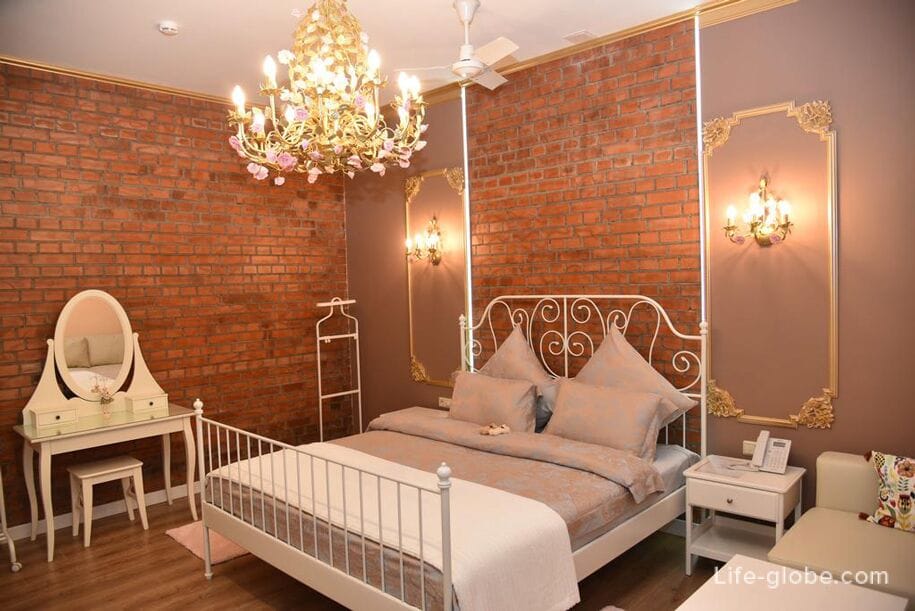
The house of the Tsarskoye Selo palace administration, built in 1744 by the architect S. I. Chavakinsky. The building housed the Palace Administration, the Tsarskoye Selo Archive, the exhibition hall, glaciers, etc.
The building was rebuilt in 1810 by the architect V.I. Geste and in 1825 by the architect V. P. Stasov. It was used for the archive and glaciers building on the corner of Lyceum Lane.
Currently, three houses are located on the site, of which only the average one-story building retains its original baroque appearance without alterations.
The building also has a classicism style.
Building address: 3 Srednaya Street / 8 Leontievskaya Street.
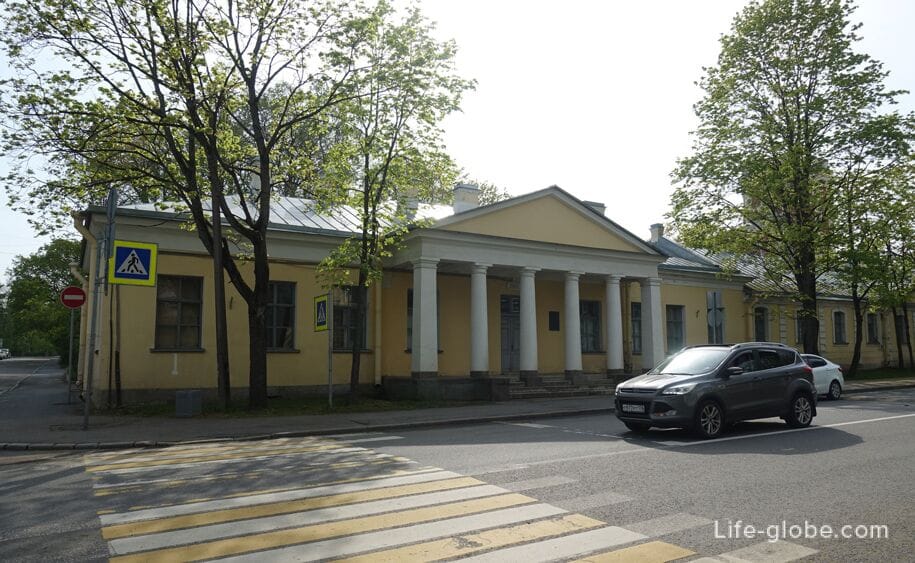
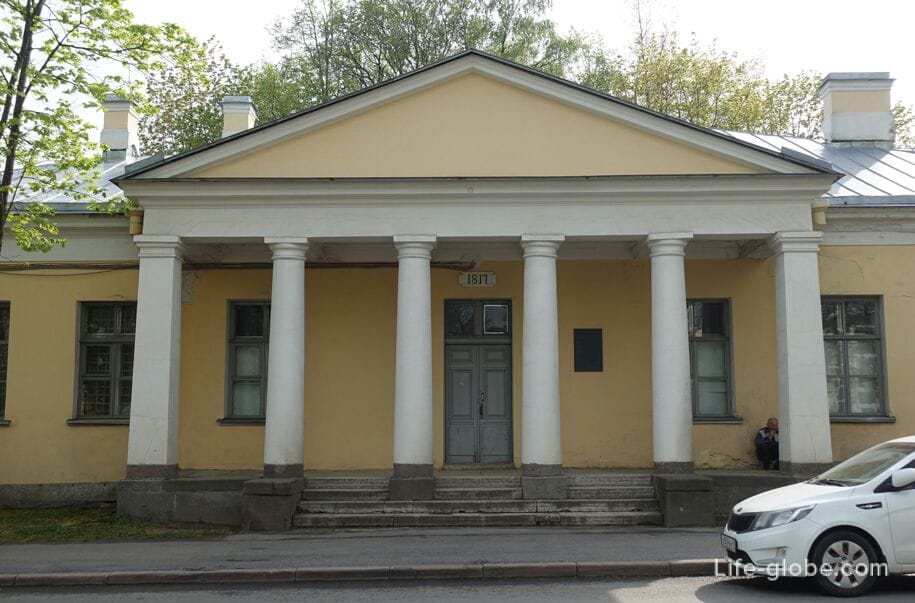
The Kanobbio House, built in 1815 by the architect V. I. Geste for the caretaker of the Taitsky water pipeline of the Tsarskoye Selo Palace Board, engineer-lieutenant Francis Kanobbio.
Subsequently, the owners of the house changed. In the 2010s, the building was adapted to accommodate a museum and a cafe.
This is a wooden house with a classicism style.
The address of the house: Leontievskaya Street, 18.
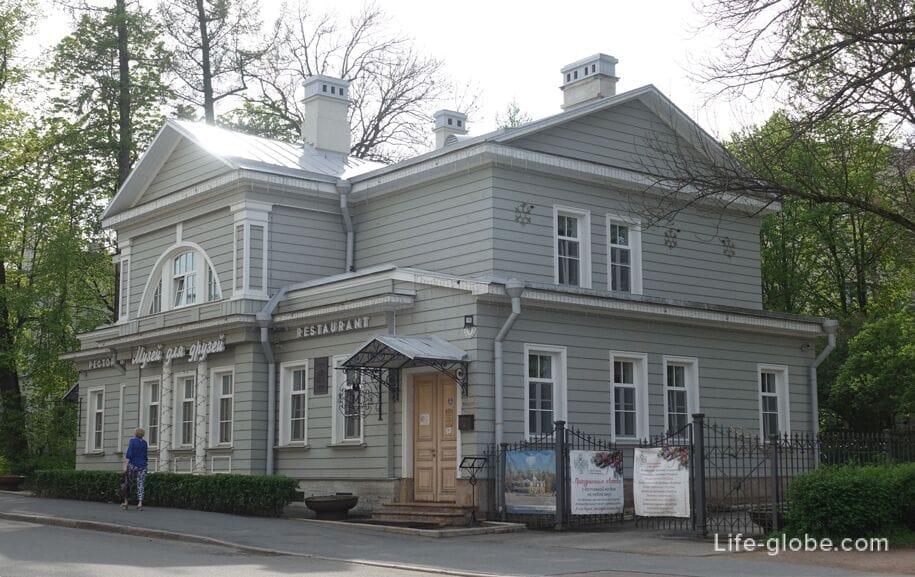
The residential building of the Palace Department, which is one of the largest historical buildings of Tsarskoye Selo. It has an internal enclosed courtyard-a square.
Building address: 6 Srednaya Street / 1 Tserkovnaya Street.
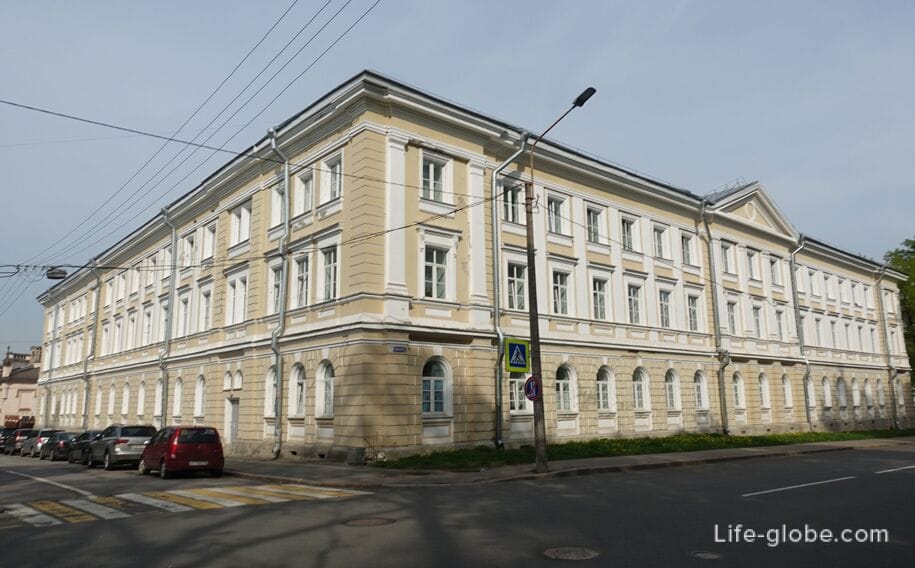
The house of L.V. Tepper de Fergusson, composer and music teacher at the Tsarskoye Selo Lyceum. It was built in the 1790s and restored in 1954-1955.
In this house, at Tepper's musical evenings, the young A. S. Pushkin and his friends-lyceum students visited.
The address of the house: 4 Srednaya Street.
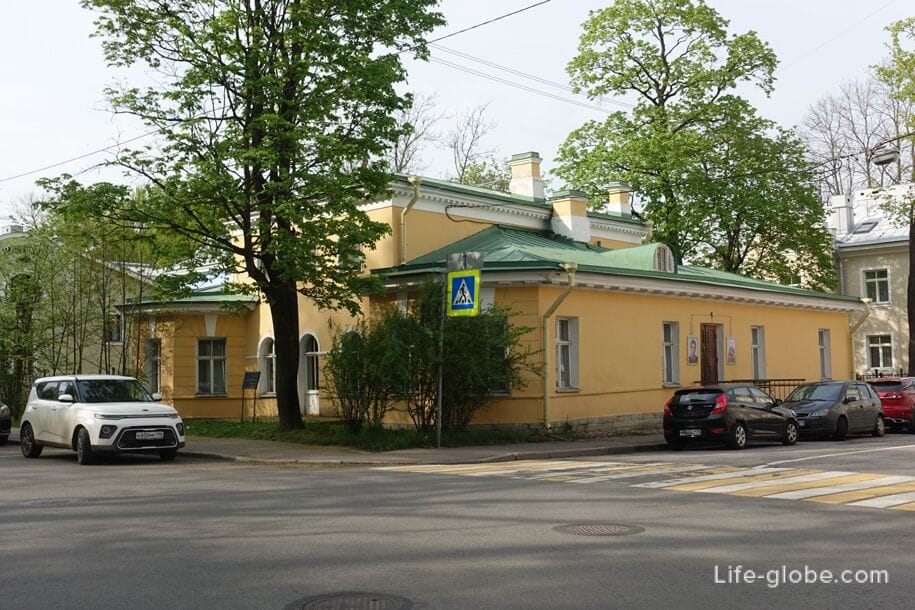
The Minigetti house . Since the middle of the 18th century, the plot on which the house is located was used by the palace Craftsmen for workshops and housing of blacksmiths, locksmiths.
In the 1820s, presumably according to the project of the architect V.P. Stasov, a one-story house with a mezzanine was built on a stone basement, which in 1858 was provided to the staff architect of the Tsarskoye Selo Palace department I.A. Monighetti. In the 1860s, the architect built the house on the second floor according to his project.
Today the house has been restored.
The facade of the building is designed in a classic character. The expressiveness of the building is given by a gable roof with a spike protruding above it and a semicircular window, triangular pediments at the ends and double windows in the center of the front facade.
Building address: Church Street, 7.
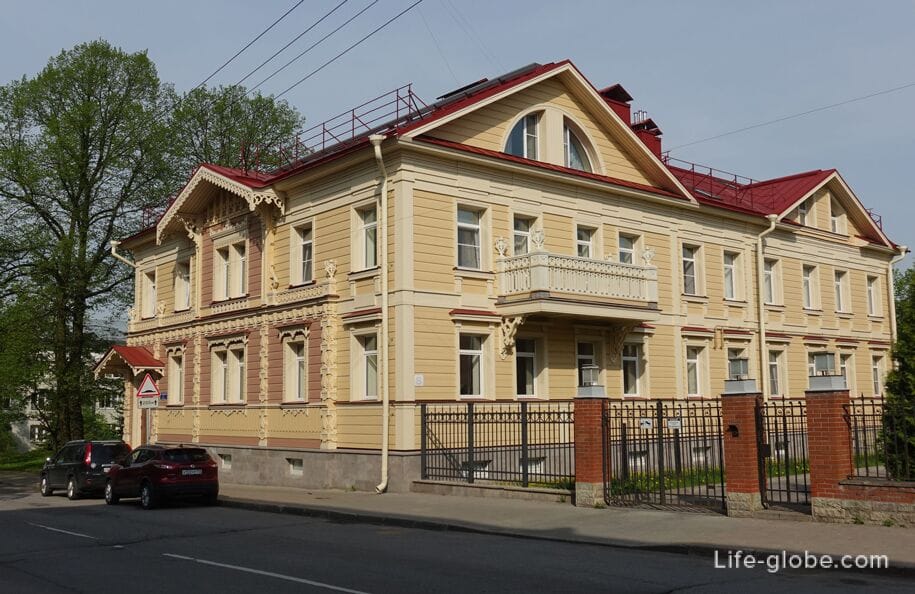
The building of the Palace Power Plant, which has a pseudo-Gothic style.
The building of the Palace Power Plant is one of the most striking historical buildings of Tsarskoye Selo. This is an early example of a composite solution of an electric station building in the historicism style using Gothic.
The building was built in 1896-1898 by the architect Danini Silvio Amvrosievich and expanded by an extension on the side of the courtyard in 1911.
Building address: 7-9 Malaya Street / 3 Tserkovnaya Street.


The service wings of the Nikolaev men's gymnasium and the City Hall, located at the address: Embankment Street, 16, 18 and 20.

The mansion of Count V.V. Gudovich, built in 1901-1906 in the Art Nouveau style by the architect S.A. Danini for the stalmeister of the imperial court, Count Vasily Vasilyevich Gudovich.
Building address: Park Street, 18.
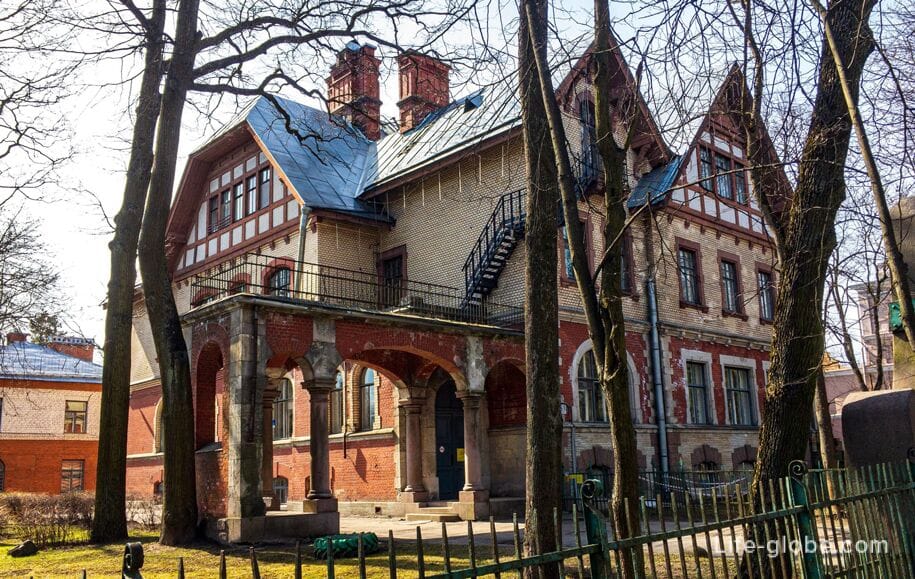
In addition to these, there are other historical buildings, churches and monuments in Pushkin.
For example: the palace of O.V. Paleva (Sovetsky Lane, 2), the mansion of V.P. Kochubey-the Rest House "Pushkino" (Radishchev Street, 4), which now houses the 3-star hotel "Kochubey Center" and the university.

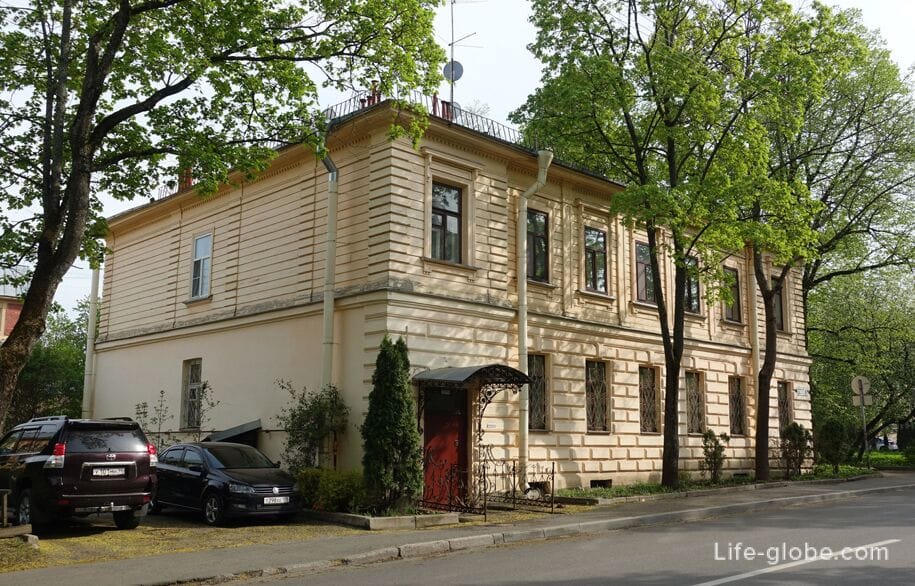
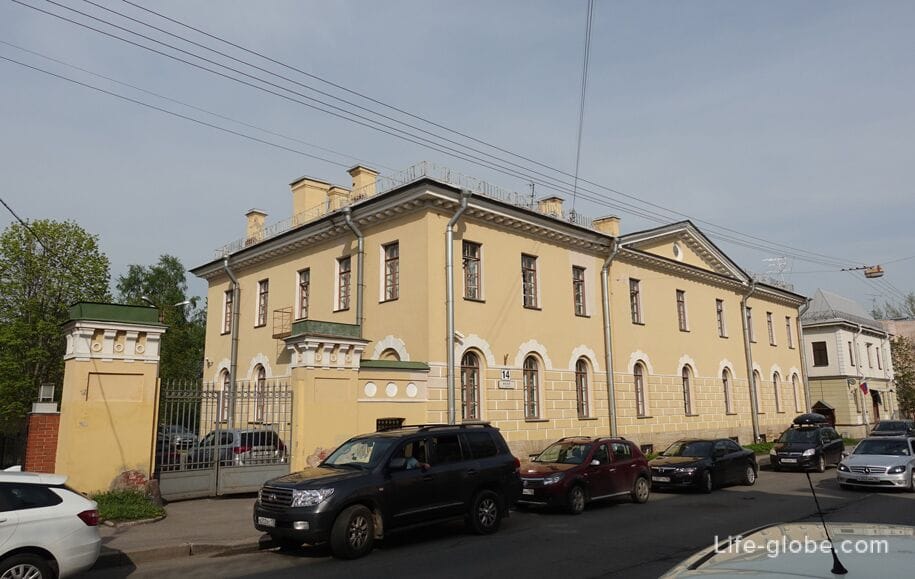
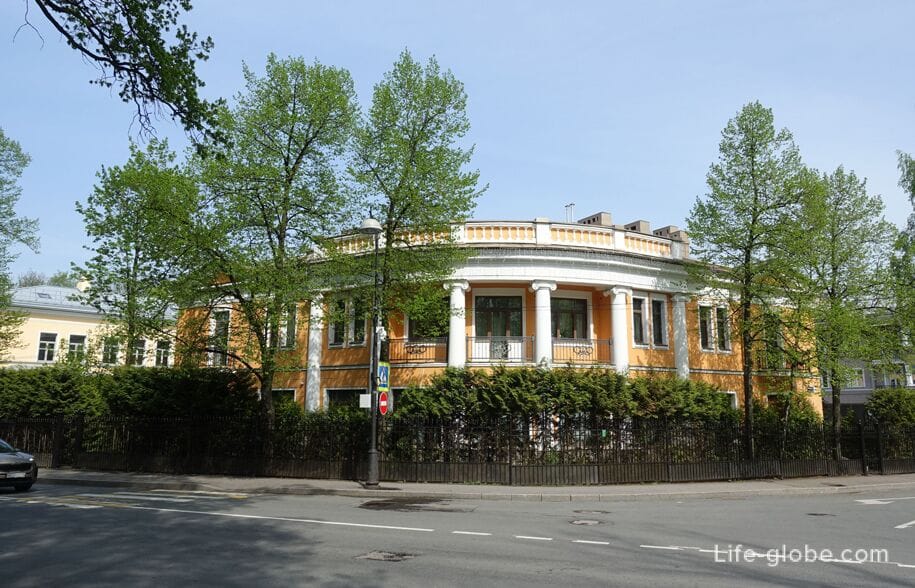
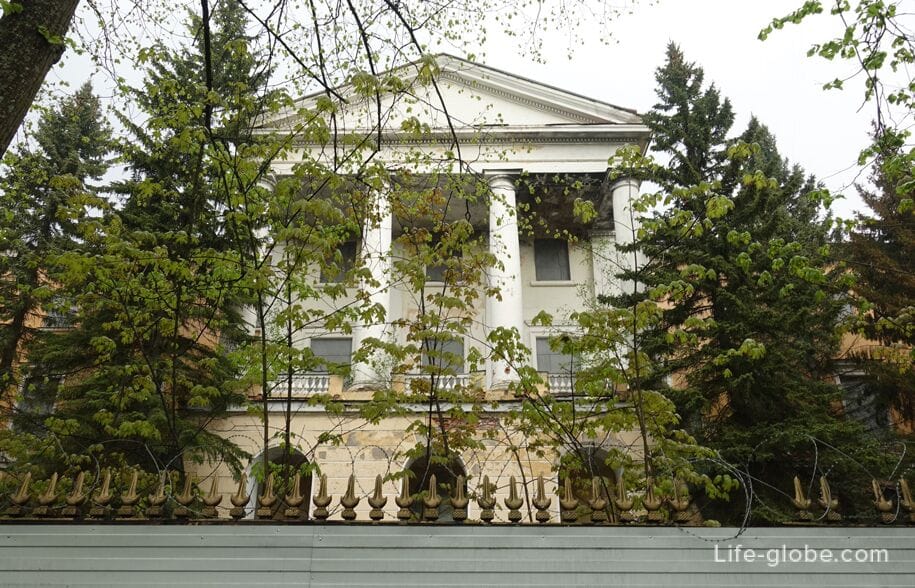
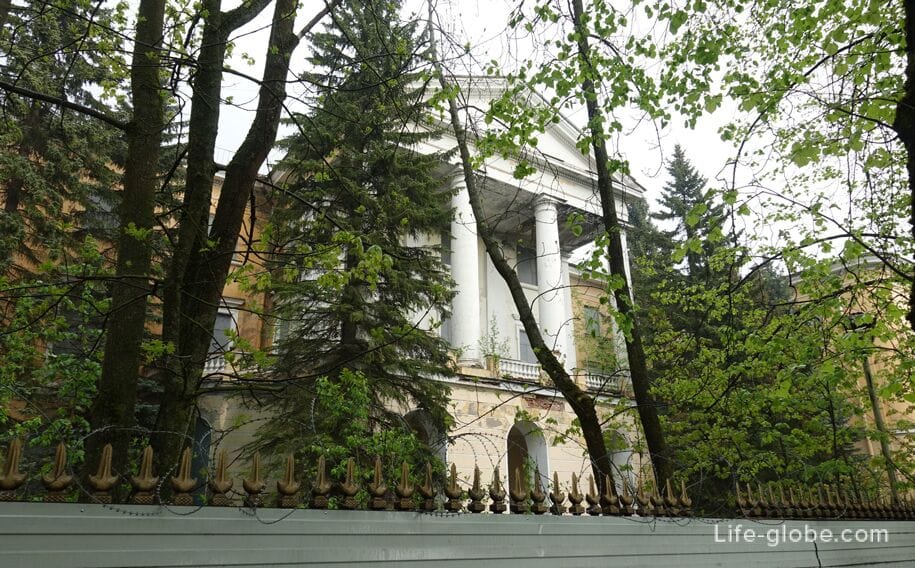
Practical information
You can find out about all the ways to get to Pushkin from St. Petersburg (the airport and the city center) here →
You can visit Tsarskoye Selo (Pushkin) with one of the excursions
All accommodation facilities in St. Petersburg, including in the city center and in Pushkin, can be viewed and booked here




